
Learning from the Pros
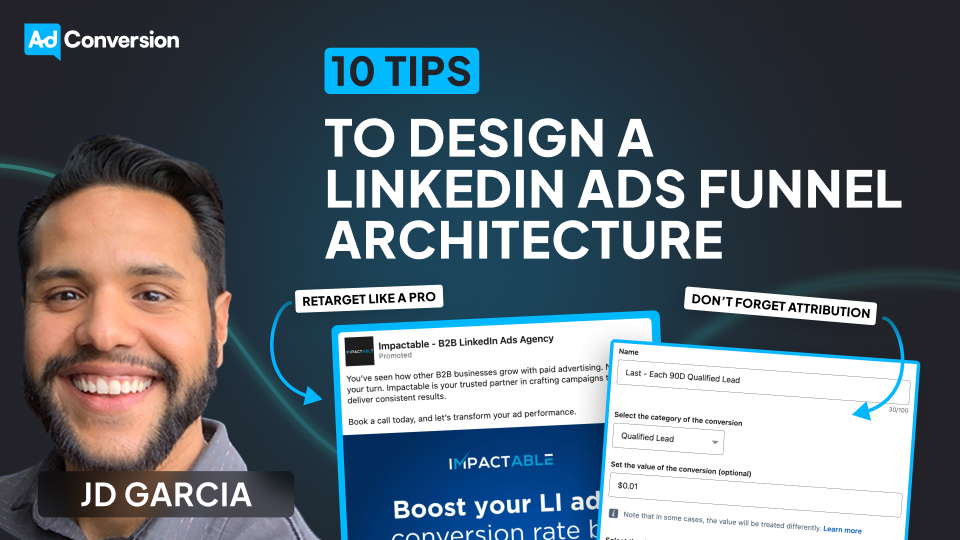
10 Tips to Design an Effective LinkedIn Ads Funnel Architecture
Over the past 5 years, I’ve helped hundreds of B2B SaaS companies develop a strong LinkedIn Ads funnel architecture.
This has allowed them to show up in front of the right audiences, with the right messages, at the right time, ultimately leading to more pipeline and revenue.
I’ll be breaking down my entire methodology below.
Let’s dive in.👇
TABLE OF CONTENTS
- Tip #1: Outline your variables
- Tip #2: Whiteboard your funnel
- Tip #3: Set clear campaign goals
- Tip #4: Create ads that match the funnel stage
- Tip #5: Don’t forget attribution
- Tip #6: Get efficient before getting fancy
- Tip #7: Retarget like a pro
- Tip #8: Test smart, not random
- Tip #9: Keep tabs on performance
- Tip #10: Learn, improve, repeat
Tip #1: Outline your variables
Before you do anything else, you want to outline all your variables.
What audiences do you need to target? Are they actually active on LinkedIn or will you have to try with a different platform? How large are your audience sizes? How much budget do you have? What content do you have available to you and what gaps do you currently have?
You need to put all those pieces on the table to understand if LinkedIn is a viable channel for you in the first place.
If you have minimal content, a small budget, and an audience that isn’t very active on LinkedIn, you’re setting yourself up for failure.

Tip #2: Whiteboard your funnel
Once you have your pieces on the table, you can use Figma, Miro, or simply pen and paper (my personal preference) to start mapping out your funnel.
For example, let’s say you’ve created your audience and have identified that your TAM is around half a million people. But maybe your ideal ICP — which you want to start targeting with ads — is only 65K people.
Now, you need to ask yourself the question: what type of content would this audience find interesting and push them further down the funnel?
Maybe, to start, they’d want to see something funny related to a pain point they’re having. Next, they might want to see more content related to this pain point, in addition to product videos and testimonials. Eventually, they might be open to requesting a demo.
Ultimately, you want to map out the journey that you want your prospects to take; even if they don’t follow this exact journey — which they probably won’t — doing this exercise forces you to have empathy for them, and your content ecosystem will be more likely to move the needle.
Tip #3: Set clear campaign goals
A goalie, defender, midfielder, and striker all have different roles and shouldn’t be judged by the same criteria.
The same is true for ad campaigns.
Top of funnel, bottom of funnel, cross-sell, upsell, and pipeline acceleration campaigns are completely different, and need to be judged by completely different metrics.
Before spending any money, it’s important to clearly define the KPIs for your campaigns.
For example, for a top of funnel campaign to a cold audience, your goal might be to maximize engagement, and you might be looking at metrics such as engagement rate and cost per engagement.
For a bottom of the funnel campaign, you might be assessing performance by looking at metrics such as cost per demo, cost per SQL, or cost per opportunity.
Defining these key metrics is essential — if you fail to define them, your leadership team might ask you to pause all your top of funnel/awareness campaigns because they haven’t generated enough demo requests 😥
Tip #4: Create ads that match the funnel stage
A lot of people these days say things like the B2B buyer’s journey isn’t linear and the funnel isn’t actually real, and sure, that’s true, but it’s still meaningful to match the content/offer to the level of awareness of your prospect.
Someone who visited your LinkedIn company page 11 months ago probably shouldn’t be seeing the same content as someone who visited your pricing page yesterday.
With the ads in the cold layer, you’re showing up unannounced in someone’s feed, and you’re simply looking to pique their curiosity.
Once they’ve engaged with you multiple times, you can start being a bit more direct (promoting demos, trials, sign ups, etc.).
Aside from the funnel stage, you also might want to segment your ads by persona — for example, CFOs, salespeople, and product people will all care about different things, and should be seeing customized messaging based on their needs and concerns.
One caveat: you have to be careful to not make your audience too small.
If you segment by region, funnel stage, and persona, you may not have a large enough audience size to run a campaign.
If this happens, you’ll have to triage and decide which targeting criteria to prioritize.
Tip #5: Don’t forget attribution
This might seem basic but it has to be said.
You don’t need a super complex attribution setup, but you do want to have an idea of what campaigns are driving an incremental lift in pipeline.
If you don’t have access to an attribution tool like Dreamdata or HockeyStack, here’s a simple way to start doing this:
For high-value conversions (ie qualified lead, demo request, or opportunity), in addition to your standard last touch/last conversion event, set up a duplicate last touch/each conversion event, with a 90-day click/90-day view window and a very small value (ie 1 cent).
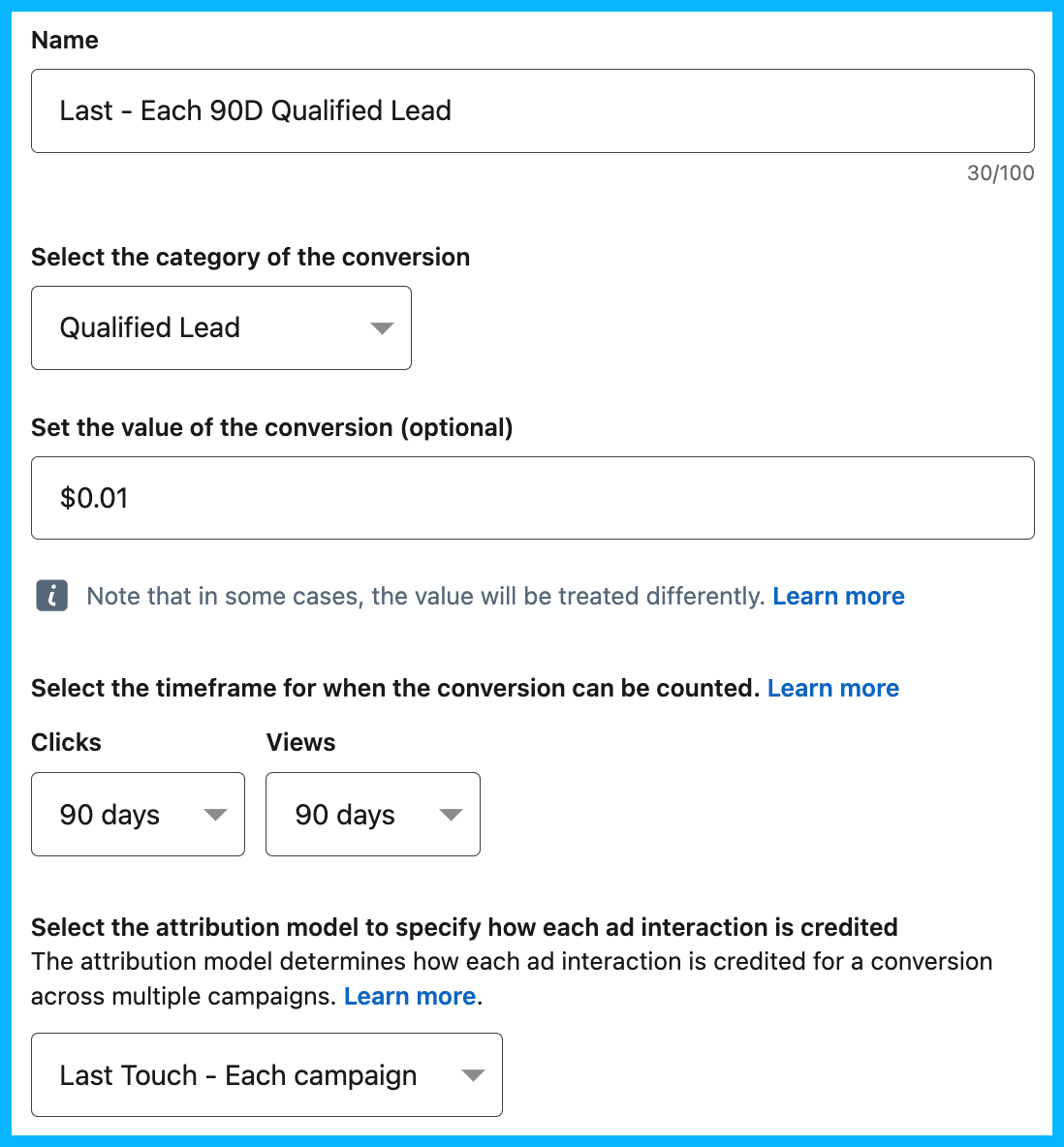
By doing this, you’ll find that some campaigns that you believed weren’t performing are actually driving — or at least influencing — a significant amount of conversions.
Aside from this, it’s a good idea to look at different sources to build a more complete picture of what’s working: in-platform attribution, your CRM, self-reported attribution, Gong call mentions, conversion API, the revenue attribution report, etc.
It’s also helpful to look at both directly attributed and blended pipeline quarter over quarter. If these numbers, along with your pipe-to-spend ratio, are consistently increasing, it’s a good indicator that your campaigns are working.
Tip #6: Get efficient before getting fancy
In order to be effective, you first need to be efficient.
I like using the example of a car: if you need to drive 50 miles, it’s going to be much more difficult if your oil hasn’t been changed, your tires are flat, and you only have a quarter tank of gas.
The same thing is true for LinkedIn Ads: using the LinkedIn audience network, enabling audience expansion, not leveraging exclusions, using too many exclusions, targeting too many people, not targeting enough people, using OR instead of AND or AND instead of OR, using the wrong campaign objective, choosing the wrong bid strategy, etc.
These are issues I see all the time, and though they may seem minor, they have a huge impact on overall performance.
You won’t hit your pipeline and revenue targets if you don’t pay attention to the smaller details.
Tip #7: Retarget like a pro
Effective retargeting requires a nuanced approach.
Prospects who have visited your site in the past 30 days are more likely to request a demo/book a call, so it’d be appropriate for them to see ads with a more direct CTA.
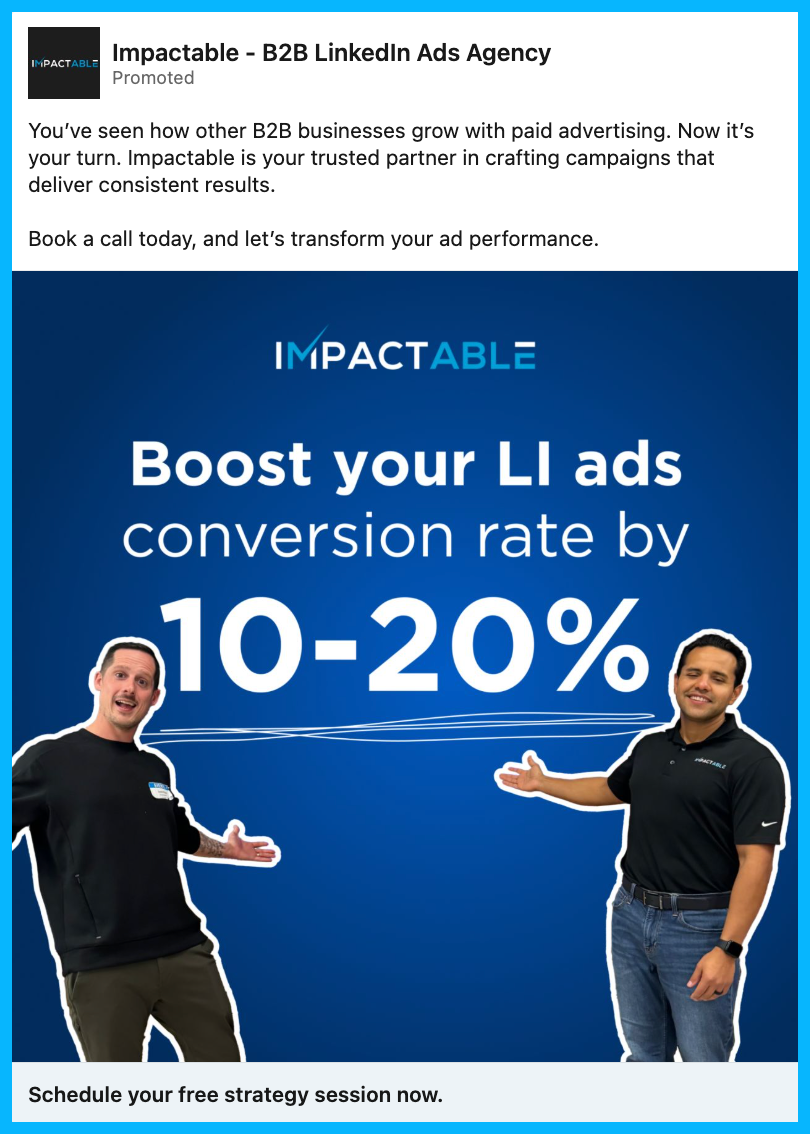
Prospects in your general 90-day remarketing audience might be considering different products/services, so case studies, testimonials, thought leadership, and other trust-building content might push them further down the funnel.
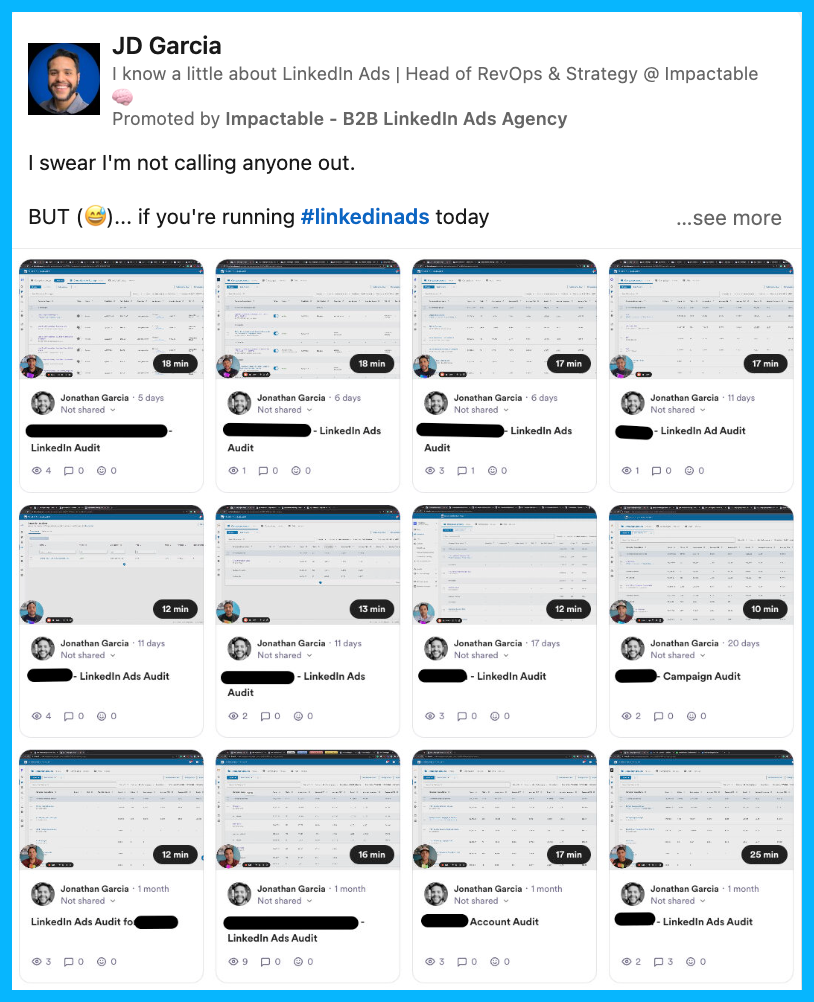
People in your 180-day remarketing audience may not be in-market anymore, but you can stay in front of them for a very low cost using different LinkedIn ad formats such as text and spotlight ads.
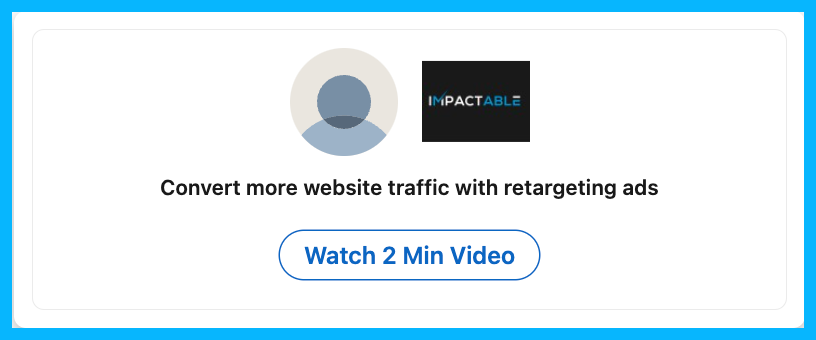
If the prospects in your 90 or 180-day remarketing audiences engage with your ads and visit your site, they’ll enter the 30-day remarketing audience and see more direct demo request/book a call ads.
If the prospects in the 30-day remarketing audience don’t engage with your demo ads, they’ll get pulled into the 90-day remarketing layer.
Ultimately, by creating this remarketing ecosystem, you’ll make sure you’re A) capitalizing on people who are in-market and B) staying top of mind with prospects who aren’t ready to buy just yet.
To learn exactly how to set up your retargeting audiences, take a look at this retargeting blueprint.
Tip #8: Test smart, not random
You should be constantly testing elements in your campaigns to maximize performance: different copy, pain points, landing pages, targeting criteria, etc.
But you want to make sure that all your tests are both meaningful and insightful.
For example, testing a blue creative vs. a red creative wouldn’t be meaningful; instead, you’d want to test more significant elements, e.g. testing one messaging angle vs. another, or testing a native audience vs. an ABM audience.
Also, it’s important to conduct proper A/B tests — they’re called A/B tests and not A/B/C/D/E/F/G tests for a reason 😅— to extract accurate insights from your experimentation. If you’re simultaneously testing copy, creatives, pain points, landing pages, and targeting, you’ll have no idea what led to an improvement in results.
Pro tip: To ensure that your tests are both meaningful and insightful, you can use this simple experimentation formula If we do X, I believe Y, as measured by Z.
Tip #9: Keep tabs on performance
This is another tip that might seem obvious, but is often overlooked.
If you’re testing campaigns with different audiences, you need to keep a close eye on which audience performs better.
If you’re testing two ads with different messaging angles, you need to see which ad has more engagement and a higher CTR.
If you’re testing two different landing pages, you need to see which page has the most engaged visits and conversions.
To be clear, I’m advocating for keeping a close eye on performance — not constantly tweaking things in your account.
If you’ve set your campaigns up strategically, you don’t need to be making changes every day, and want to give LinkedIn’s algorithm the time to optimize and learn.
Pro Tip: I typically recommend allowing an ad to spend around $100 before shutting it down — sometimes, an ad that starts out slow can end up being a top-performer.
Tip #10: Learn, improve, repeat
With ad campaigns, you never reach a final destination; in other words, your job is never finished.
If your ads performed well this quarter, you’ll need to find a way to improve performance the following quarter.
You’ll have to sit down and ask yourself:
1. What worked well that we should continue doing in the future?
2. What didn’t go well that we should pause moving forward?
3. Based on what we’ve learned, are there any new tests that could move the needle and improve results?
If you aren’t constantly improving, you’ll likely get left behind by the competition.
Hope you found this article helpful!
If you’re looking to learn more about LinkedIn Ads, check out these free LinkedIn Ads courses, that will teach you how to launch, optimize, and scale LinkedIn Ads campaigns effectively.
And if you have any questions about LinkedIn Ads, feel free to send me a message on LinkedIn.
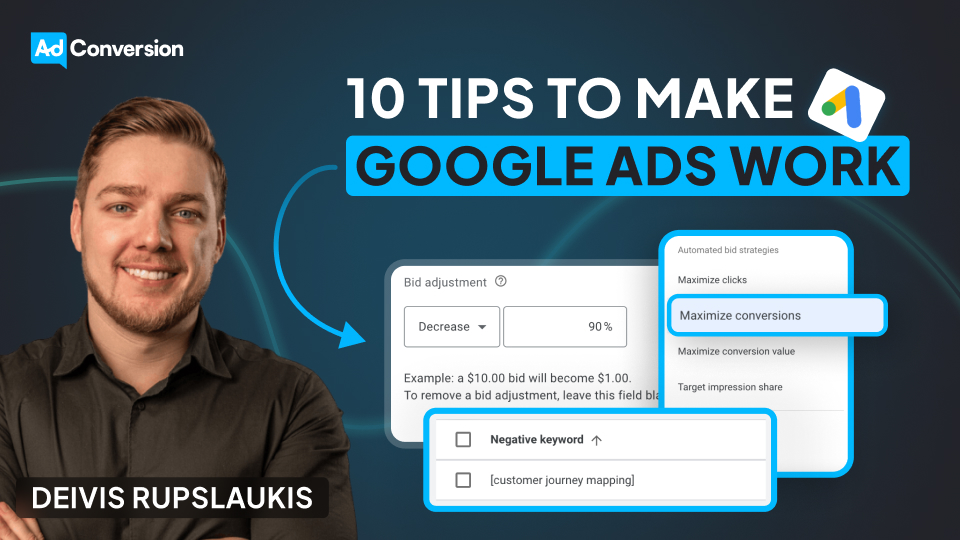
10 Tips to Make Google Ads Work for Your B2B SaaS Company
Running Google Ads today isn’t the same as running Google Ads in 2015.
What years ago was a winning strategy no longer is, and will only lead to headaches, poor leads, and wasted spend.
Many marketers have already abandoned Google entirely, claiming that it doesn’t work anymore or it’s a waste of money — but this, in my experience, isn’t true.
Over the past few years, I’ve helped B2B SaaS companies such as Dreamdata, Airtame, and Templafy drive millions in revenue through Google Ads, and have developed a repeatable strategy to maximize performance.
I’ll be sharing my tips for success below 👇
TABLE OF CONTENTS
- Tip#1: Set up quality conversion tracking
- Tip #2: Consolidate your campaigns and ad groups
- Tip #3: Focus on exclusions
- Tip #4: Create fast and relevant landing pages
- Tip #5: Leverage smart bidding
- Tip #6: Decrease the amount of RSAs per ad group
- Tip #7: Pin you headlines
- Tip #8: Don’t forget about device adjustments
- Tip #9: Figure out whether you should bid on your own brand or not
- Tip #10: Separate Brand and Non-Brand in your reporting
- Bonus tip: Dive deeper into your performance by country
Tip #1: Set up quality conversion tracking
Many companies are simply tracking form submits, without paying attention to lead quality. This makes optimization challenging, both for the performance marketer managing the account and for the Google Ads algorithm.
To improve performance, make sure you send all the lifecycle stages from your CRM back into the Google Ads platform — this might look like MQLs, SALs, opportunities, etc. — and assign higher values to higher value conversions, so that Google’s algorithm understands what to optimize for.
If you’re using HubSpot as a CRM, this process will be very simple, as your Click IDs will automatically be captured without requiring a manual setup.
If you’re using a different CRM, you’ll need to manually push your click IDs into your CRM using hidden fields — this process might seem complicated, but you should be able to find a marketing operations specialist on Upwork that can help you with the initial setup.
Tip #2: Consolidate your campaigns and ad groups
In the past, when exact match was still exact, SKAGs (single keyword ad groups) made sense.
By including one keyword per ad group and using that keyword in the ad and landing page copy, you could improve your overall quality score.
Now that exact match is a lot less exact, this approach doesn’t make sense anymore.
These days, consolidation is the way to win — by grouping relevant keywords into the same ad group, we give the Google Ads algorithm more data points to make optimizations.
Tip #3: Focus on exclusions
With exact match being less exact, exclusions are now more important than inclusions.
In other words, instead of trying to come up with hundreds of keywords to include in your campaigns, it’s better to spend your time excluding hundreds of irrelevant keywords.
For example, maybe you want to show up for the keyword customer journey tracking, but notice in your search terms report that you’re consistently showing up for the term customer journey mapping, which isn’t relevant to your core offering. By excluding different variations of customer journey mapping, you’ll be able to improve your overall targeting and get in front of more relevant prospects.

Pro tip: In the Google Ads reporting section, you can easily create a search terms report and schedule it to be emailed to you on a weekly basis. This will allow you to be more proactive about making exclusions in your account.
Tip #4: Create fast and relevant landing pages
Landing pages are one of the most overlooked aspects of Google Ads performance.
If they aren’t loading quickly, Google will lower your quality score and it will be nearly impossible to get in front of your prospects. Before launching any campaign, double check that your landing pages are loading quickly on both mobile and desktop devices.
Next, make sure your landing page is as closely related as possible to the keywords in your ad group. For a product analytics ad group, you’d want your landing page to focus on product analytics. For a marketing analytics ad group, you’d want your landing page to focus on marketing analytics.
Take a look at the customized landing pages below:
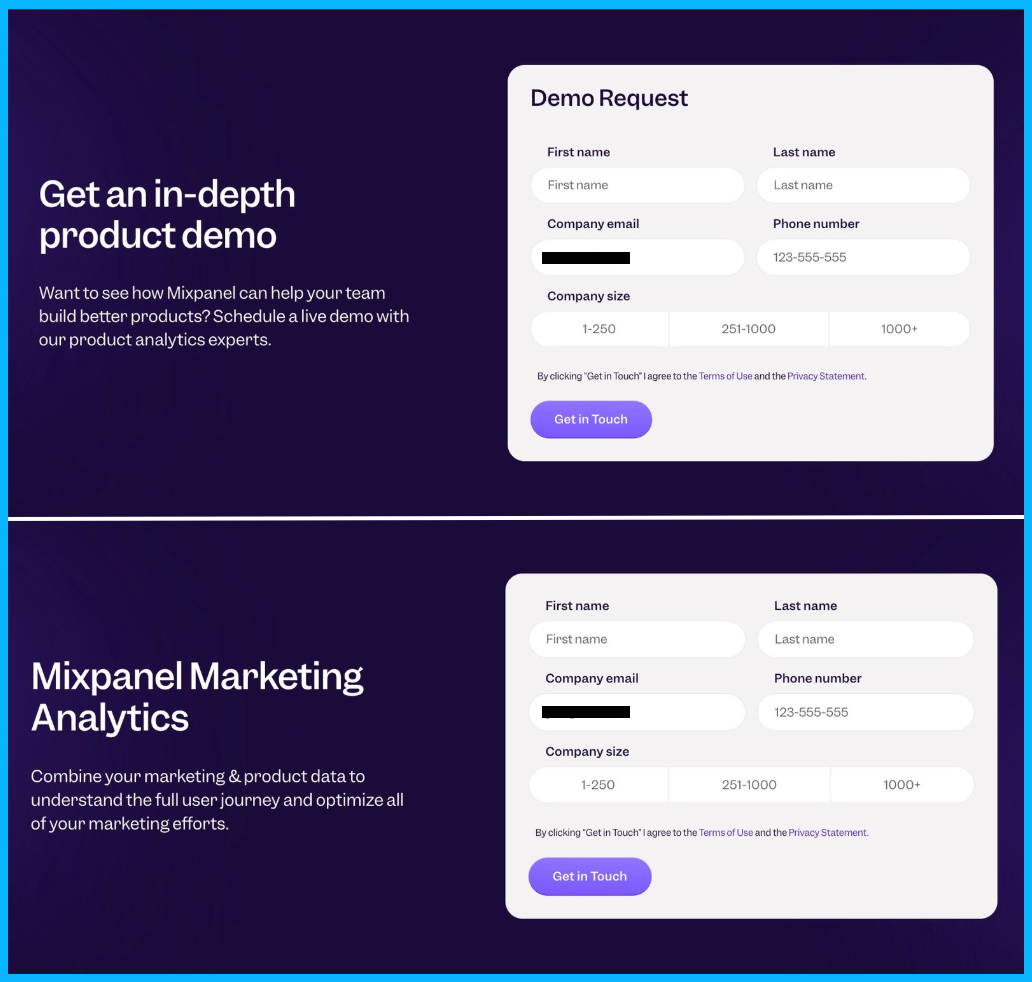
This message match will improve your quality score and will also improve the relevance for your prospects, leading to better performance.
I know that creating new landing pages can be a heavy lift, especially if you have a small team. If this is the case, I recommend duplicating an existing landing page and simply modifying the hero section. Once you start seeing some initial traction from this simple landing page, you can put in the extra effort to create a fully customized experience.
Pro tip: To check the speed of your landing pages, you can use a free tool such as PageSpeed Insights.
Tip #5: Leverage Smart Bidding
Sometimes, smart bidding doesn’t make sense. For example, if you’re starting a new campaign and have zero conversions, it’s a better idea to start with manual CPC or maximize clicks with a bid cap.
However, once you have 10+ conversions per campaign, you’ll typically see better performance if you switch over to smart bidding and let Google optimize for you.
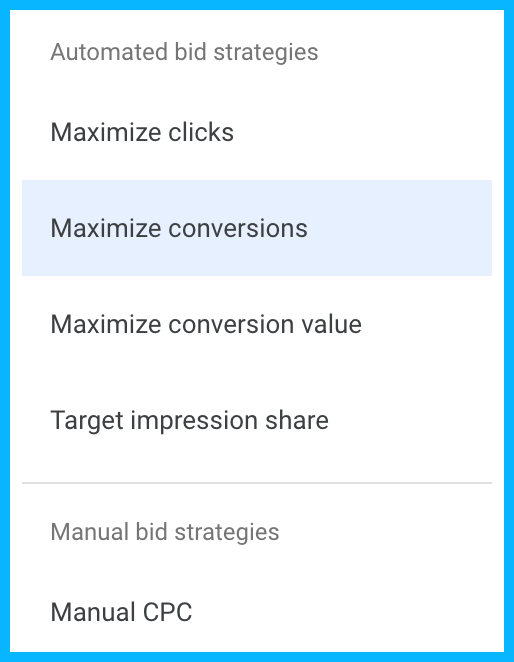
This wasn’t always the case — in the past, Google’s algorithm was much less sophisticated, and you were better off trying to control every single bid adjustment.
But these days, you’ll usually see more traffic and an increase in conversions by letting go of control, as long as you’re feeding Google high quality signals from your CRM.
As with everything in marketing, there are exceptions, and there are instances where you’ll switch to smart bidding and your CPCs will skyrocket 😨
If this happens, consider testing a portfolio bidding strategy with a target CPA and a bid cap — this will mimic max conversions bidding while giving you more control over the cost per click.
Tip #6: Decrease the amount of RSAs per ad group
Most people think that having more responsive search ads = more variations for Google = better performance.
But the opposite is actually true.
Let’s say you create 3 RSAs, and have 15 headlines per ad. This means that Google will have to test 45 different headlines until it finds a winning combination, which could take years 😅
If you only include 1 RSA per ad group (maximum two), your headlines will be tested much faster and Google will be able to find a winning combination more easily, minimizing wasted spend and improving overall results.
Pro tip: If you have a small budget, you might want to take things a step further, and test 6-9 headlines instead of 15. This way, Google will be able to test all the headlines in a matter of weeks (not years).
Tip #7: Pin your headlines
There’s still a lot of debate around pinning vs not pinning headlines.
Some people say that pinning is a bad idea, since it will negatively impact your ad strength, but ultimately, Google’s ad strength has no bearing on performance.
I’ve seen more success with pinning because it makes your headlines more legible — if your ads are clear and searchers have a better understanding of what your company does, you’ll see an improvement in performance.
If your headlines are redundant — as often happens with unpinned headlines, which leads to words like Google Ads agency and Google Ads consultant being next to each other — prospects are less likely to trust you, and much less likely to click.
Here’s the exact formula that I like to follow for my headlines:
Headline 1: Include your target keyword to maximize relevance
Headline 2: Include unique selling points or social proof
Headline 3: Include your company name or a relevant CTA

For each headline, I like to create 2-3 variations that Google can test.
Pro tip: Spend most of your time crafting headlines 1 and 2. Headline 3 is much less important these days, as Google rarely displays it in the SERP.
Tip #8: Don’t forget about device adjustments
Oftentimes, certain devices will significantly outperform others.
For example, if you see that 20% of your spend and 90% of your conversions are happening on desktop, you might want to add a negative bid adjustment to mobile devices or tablets, in order to increase the budget allocated to desktop.
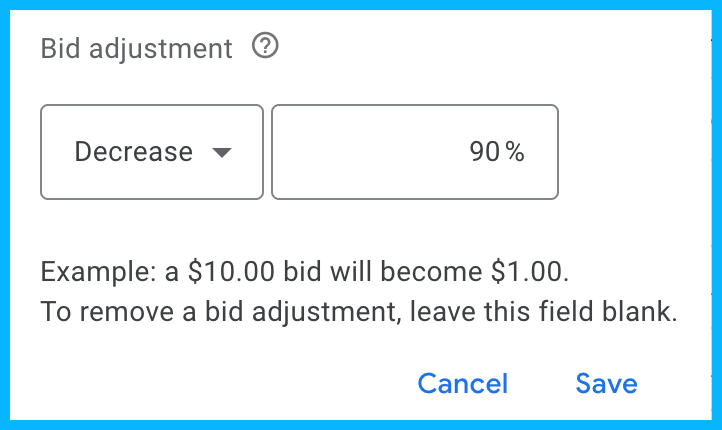
You could argue that mobile impressions are still valuable, and that decreasing spend on mobile could negatively impact performance if people are researching on their phones and then converting on desktop, but based on my experience, it’s best to work with the data that’s available to you — if a certain device is converting at a higher rate, I would recommend adding negative bid adjustments to the other devices.
Tip #9: Figure out whether you should bid on your own brand or not
Running brand campaigns vs not running them at all is a controversial topic.
Some people say that the impact of brand campaigns is minimal — prospects were already looking for you and may have converted organically — and that they simply exist to inflate performance marketing metrics.
However, in my experience, this isn’t the case, and it usually is a good idea to run brand campaigns to protect your brand, especially if competitors are bidding on your company name.
Back when I was working at Momondo, a B2C company, we were driving a ton of revenue from competitive campaigns, bidding on our competitor, Kayak, who wasn’t running brand campaigns to protect themselves.
Now, you might be thinking: sure, that’s B2C, but in B2B, especially enterprise B2B, you probably won’t change the course of a deal with a single ad.
But from what I’ve seen with my B2B clients, this isn’t true — my clients have driven a significant amount of revenue by bidding on competitor terms, which validates that bidding on your own terms to protect yourself is a good idea.
Check out the example from Mixpanel below. If they didn’t bid on their own brand name, competitors like Pendo and Heap might end up stealing some of their prospects.
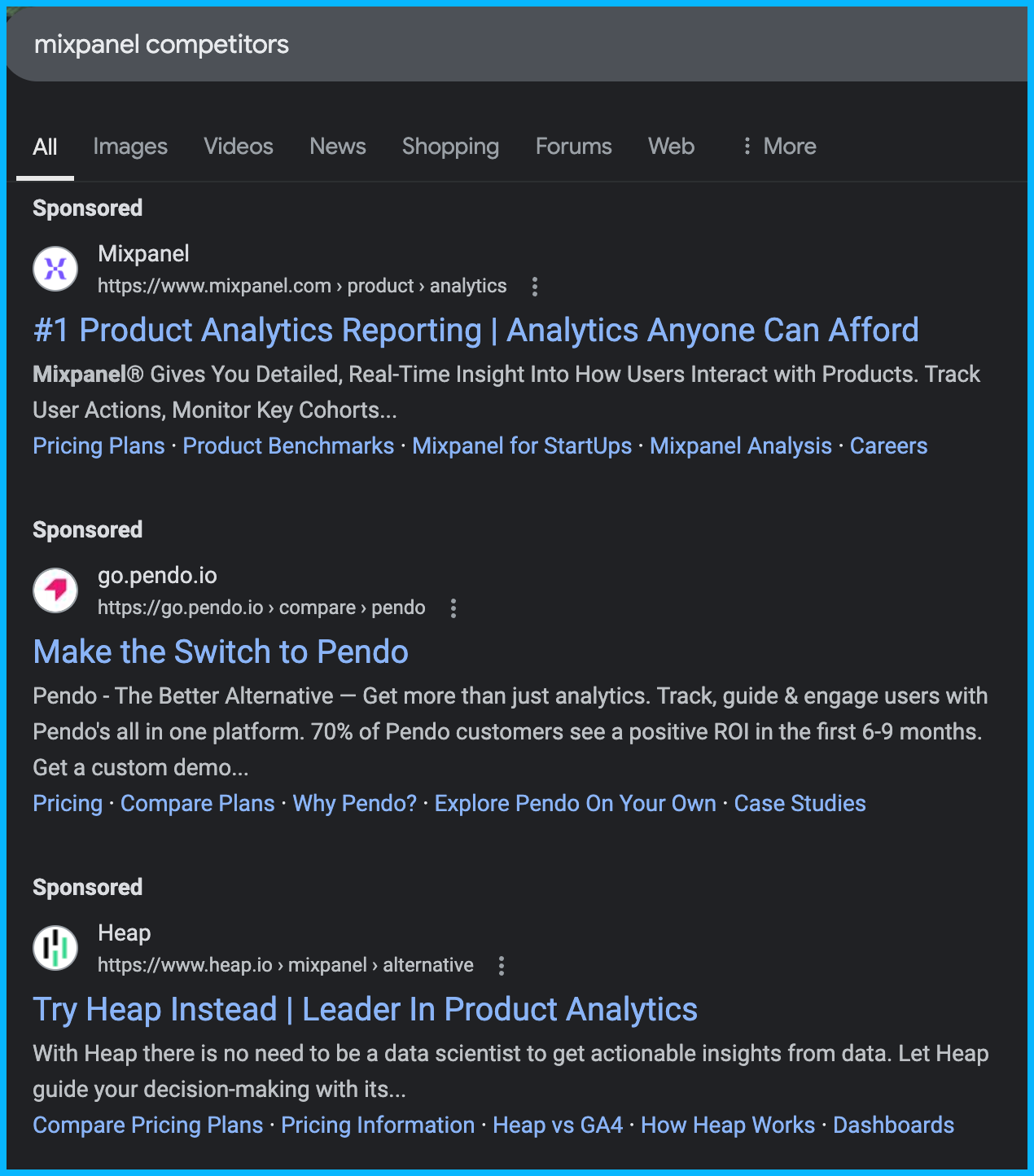
If you’re undecided about whether you should run brand campaigns or not, you can run a holdout study.
Stop running brand campaigns in a specific region — maybe start with one of your less important regions — and see if the amount of demos or trials goes down. If it does, you can assume that you’re losing out on pipeline and revenue by not bidding on your own terms.
Tip #10: Separate Brand and Non-Brand in your reporting
Brand and non-brand campaigns are completely different.
Brand campaigns are defensive. Someone already found out about your brand through other marketing efforts, and they’re looking for you specifically — you’re bidding on your own name in order to protect your brand from competitors trying to steal your traffic.
On the other hand, non-brand campaigns are offensive. You’re trying to show up for relevant solutions that your prospects might be looking for, and you’re trying to drive interest from a colder audience.
In other words, getting a conversion on a non-brand campaign is significantly more challenging than driving a conversion on a brand campaign; you need to separate these campaign types in your reporting to truly understand what’s working.
Bonus tip: Dive deeper into your performance by country
Most companies and ad agencies tend to look at performance by region, but completely ignore performance by country, which results in inefficient spending.
For example, if you’re targeting France, Italy, Spain, DACH, Nordics, and the UK in the same campaign, if you drill down and analyze performance by country, you might realize that all your spend is going to the southern European countries, which typically have more affordable CPCs.
And if you look further down the funnel, you might see that Spain, DACH, and Nordics are generating a lot of form submissions, but that all your pipeline is actually coming from the UK.
Ultimately, you want to ask yourself:
1. Are any countries cannibalizing my spend and do they need to be separated into different campaigns?
2. Are there countries that aren’t generating any form submissions that we might want to pause?
3. Are there countries that are generating submissions but never convert into pipeline that we might want to invest less money in?
If you ask yourself these questions consistently, you’ll be in a much better position than 99% of companies.
Hope you found this article helpful!
If you’re looking to learn more about Google Ads, check out these free Google Ads courses, that will teach you how to launch, optimize, and scale Google Ads campaigns effectively.
And if you have any questions about Google Ads or paid media in general, feel free to reach out on LinkedIn.
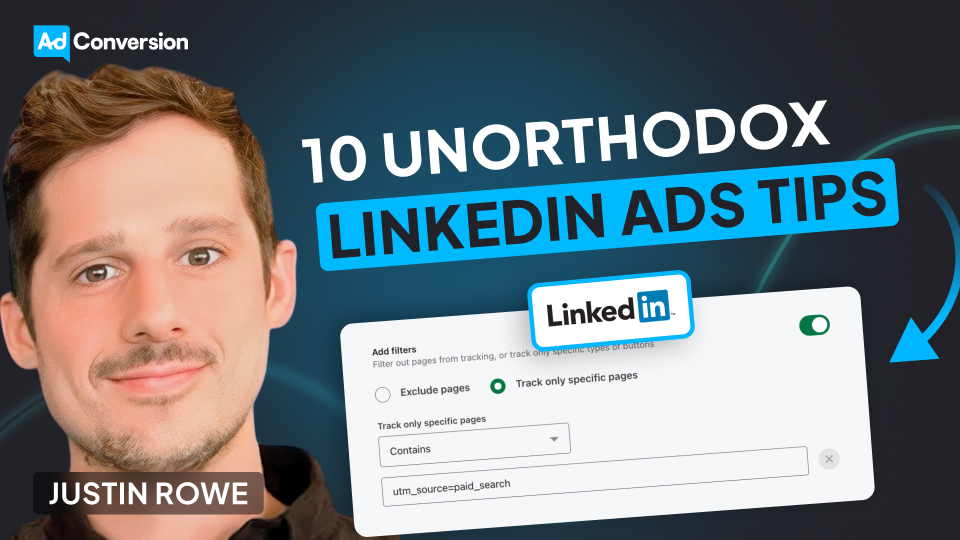
10 Unorthodox Tips to Maximize the Impact of Your LinkedIn Ad Campaigns
If you’re a marketer with some paid media experience, you’ve likely heard the same LinkedIn Ads advice many times: disable audience expansion, turn off the LinkedIn audience network, use manual bidding, etc.
This is all great advice, but following it doesn’t guarantee success – as the LinkedIn Ads market becomes increasingly saturated, it takes a more advanced approach to be successful.
Below, I’ll be sharing some less common strategies that my LinkedIn Ads agency has used to generate millions in revenue, and that you can implement to take your LinkedIn Ads performance to the next level.
TABLE OF CONTENTS
- Tip #1: Leverage the LinkedIn Insight Tag
- Tip #2: Implement a solid paid search strategy
- Tip #3: Review the intent of your search terms on Google
- Tip #4: Use video
- Tip #5: Communicate with your sales team
- Tip #6: Have a monthly and quarterly maintenance plan
- Tip #7: Experiment with organic content
- Tip #8: Use thought leader ads
- Tip #9: Leverage ad scheduling
- Tip #10: Use LinkedIn Sales Navigator to connect with your ICP
- Conclusion
Tip #1: Leverage the LinkedIn Insight Tag
This might sound silly, but I think it’s important to say it: Make sure you’re leveraging the LinkedIn Insight Tag to its full potential.
I’ve audited so many accounts where the insight tag isn’t installed and all the spend is going to cold audiences, and I’ve also seen accounts where the tag is installed, but the right audiences haven’t been set up.
As soon as you create your account, set up your 30, 90, and 180-day website visits remarketing audiences – these audiences are extremely high value and aren’t retroactive.
In other words, if you set them up 6 months after creating your account, you’ll miss out on 6 months of website traffic that you could retarget 😢

If you haven’t installed the insight tag already, check out this tutorial.
And for a full breakdown of the remarketing audiences you can create in LinkedIn Campaign Manager, take a look at this comprehensive guide.
Tip #2: Implement a solid paid search strategy
One of the best ways to improve your LinkedIn Ads results is to implement a solid paid search strategy – this could be Google Ads, Bing, or another paid listing.
Although LinkedIn’s targeting capabilities are incredible, you’re typically reaching a colder audience that isn’t actively searching for your solution, and have to take them from unaware to aware before driving conversions, which means longer sales cycles.
Meanwhile, with paid search, you can target people who are looking for your exact solution or researching the pain points you solve and shopping for vendors/solutions.
By running search ads and then retargeting with LinkedIn Ads, you can stay in front of in-market, warm audiences that are already problem and brand-aware, and significantly shorten your sales cycle. You can even qualify this in-market search traffic by layering in LinkedIn’s demographic and firmographic targeting filters on top of your warm website traffic to only retarget high-fit prospects.
Pro tip: If you’re investing a lot of money in paid search (30K+/month), you might be able to create a custom LinkedIn Ads remarketing audience with the UTM source “paid_search”, or “cpc”, or “google”. This way, you’ll only retarget high-intent prospects who have already clicked on your search campaigns.
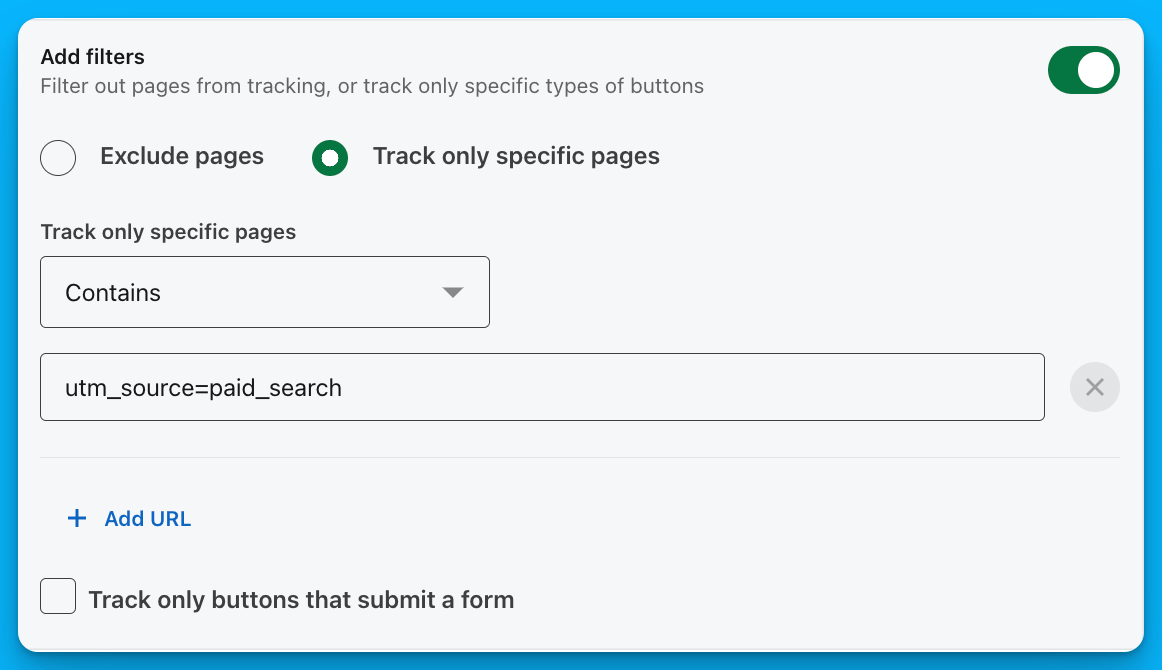
Tip #3: Review the intent of your search terms on Google
There’s no point in running search campaigns if you’re not getting in front of your ICP.
If you’re a performance marketer working at an agency, make sure you communicate with in-house marketers to confirm you’re showing up for the right search terms – their feedback is essential, because they know their business and ICP better than you do.
To make things simple, send the team a search terms report bi-weekly or monthly, and ask for feedback on what to exclude.
By doing this, you’ll improve the quality of your Google Ads traffic, and also significantly improve the quality of your LinkedIn Ads remarketing audiences.
Tip #4: Use video
Video is one of the most impactful formats on LinkedIn, as it allows you to build trust, communicate your value, and showcase your personality more effectively than images.
If you work at a service-based company, you can steal the exact strategy I use at my agency:
1. Target your cold audience with videos that clearly describe what you do and what problems you solve – these videos don’t have to be super exciting, but they do have to be relevant to the right audience and weed out people who aren’t in your ICP.
2. In remarketing, use clips of yourself speaking on well-known podcasts – this will help you build more credibility with your ICP and make them more likely to reach out.
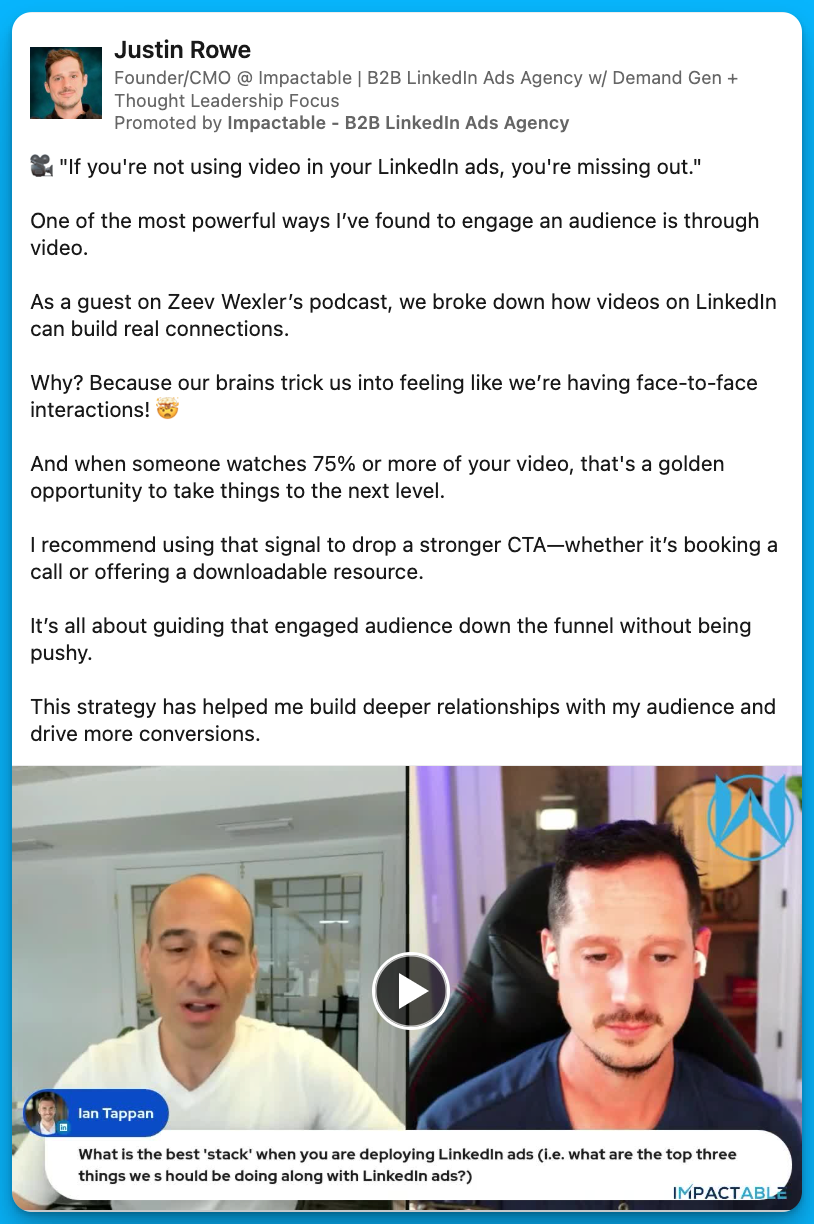
If you‘re selling a product instead of a service, run video ads showcasing how leaders in your industry use your product to solve their problems – this third-party validation is extremely powerful and has helped my SaaS clients generate millions in revenue over the past few years.
Tip #5: Communicate with your sales team
There’s no point in having great CPCs, CTRs, and CPLs if the sales team has no interest in working with your leads.
At minimum, I’d recommend meeting with your sales team once a month to go over your lead quality – these conversations will help you refine your targeting and exclusions, and minimize the amount of ad dollars being wasted.
In addition to this monthly check-in, you can go one step further and set up automated lead alerts in Slack (using Zapier). When these alerts come in, your sales team can react – thumbs up for a good lead and thumbs down for a bad one – and you can use these reactions to get real-time feedback and make quick pivots in targeting.
Tip #6: Have a monthly and quarterly maintenance plan
This might seem a bit boring, but it’s important to have a monthly and quarterly maintenance plan for your account – the same way you have a maintenance plan for your car or for your health.
For example, if you launched new video campaigns, did you create video view audiences and add them to your remarketing campaigns? Is your insight tag still active and picking up website traffic? Is your ad budget staying on LinkedIn and not being wasted on the LinkedIn audience network? Are your conversion events still functional, or do you have to update them due to changes in your website URLs?
Without these consistent checks, things can easily go awry and you can waste thousands or even millions of dollars.
Here’s the exact maintenance checklist that we use with our clients – feel free to make a copy and use it for your own accounts.
Tip #7: Experiment with organic content
If a piece of content performs well organically, it will most likely also perform well as an ad.
Use organic social media as a testing ground – test different pain points, messages, formats, and styles, on both personal accounts and your company page, and make note of what’s attracting meaningful DMs and high-quality leads.
Once your posts have received a solid amount of engagement, you can boost them to your ICP and turn them into evergreen assets that will continue to generate inbound leads with minimal effort.
By maximizing distribution via paid, you’ll improve your organic performance, and by testing new concepts via organic social, you’ll improve the ROI on your paid media efforts.
Tip #8: Use thought leader ads
Posts from thought leaders will consistently outperform ads from company pages. This is partially due to a mindset shift – when we post from our personal pages our reputation is on the line, so we try to be less promotional and more helpful.
That being said, even if you promote the same exact post from a company page vs a thought leader’s page, the thought leader ad will typically perform better – this confirms that the saying is true: people want to buy from people, not companies.
By running thought leader ads, you can expect to see:
1. Increased engagements, which will allow you to build your remarketing audiences more quickly
2. An increase in LinkedIn DMs from qualified prospects
3. A spike in organic search traffic
4. An incremental lift in conversions (my agency saw a 15-20% increase)
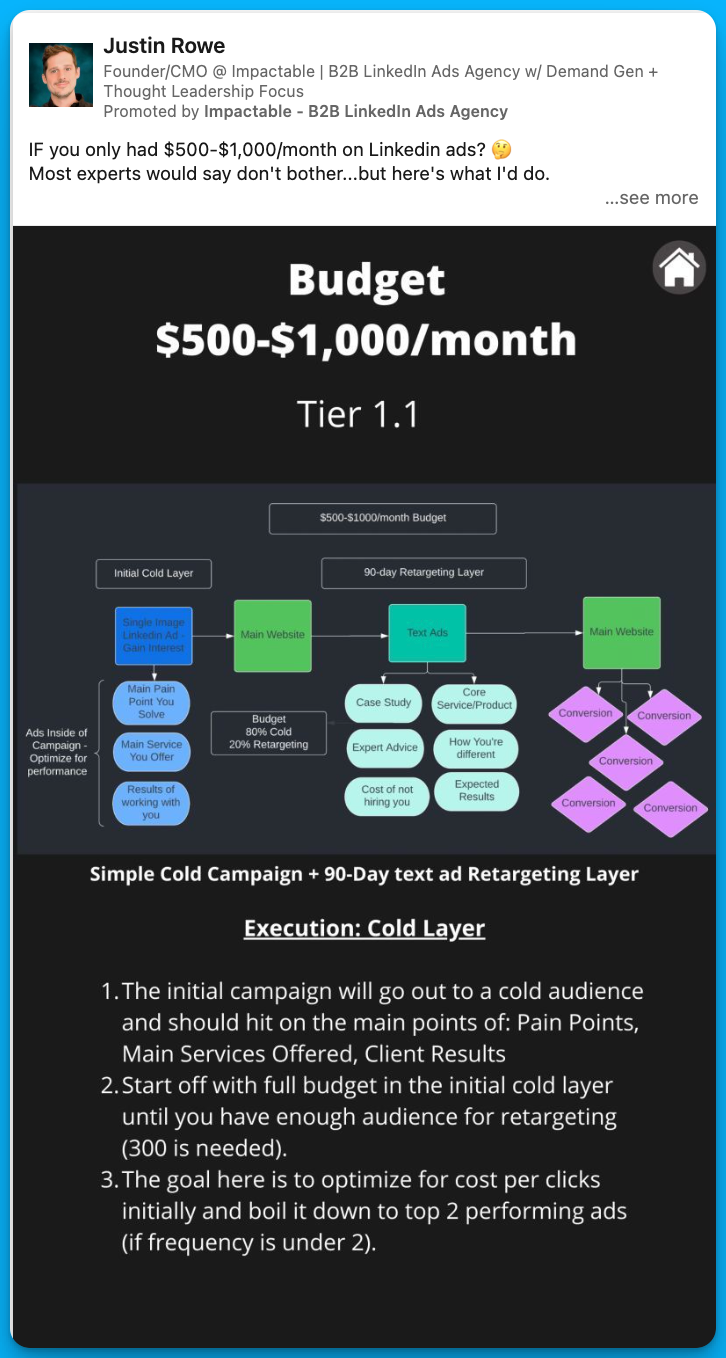
Pro tip: Experiment with different types of thought leader ads (videos, images, text, custom graphics) and double down on whatever works best.
Tip #9: Leverage ad scheduling
LinkedIn Ads start running on UTC time (8 p.m. EST), which means that a lot of companies are spending their money at nighttime and run out of budget by 5 or 6 a.m. – this leads to poor performance, as prospects are typically not as receptive to ads at these hours.
With ad scheduling, you can ensure that your ads are showing up at the right times.
For my agency, I like to run ads from 5 a.m. to 2 p.m. EST, pause in the afternoons, and restart in the evenings. For you, this schedule might look a bit different, based on when your ICP is most active.
In addition to scheduling, it can also be interesting to experiment with ad rotation, especially if you’re a smaller company with limited budget.
For example, you could run 3 campaigns on Monday, Wednesday, and Friday, and 3 different campaigns on Tuesday, Thursday, and Saturday.
Typically, to run 6 campaigns you’d need a budget of at least $60/day (due to LinkedIn’s $10/day per campaign minimum), but with ad rotation, you’d only need $30/day – in other words, your budget would go a longer way and you’d be able to reach more audiences.
Ad scheduling and rotation may not be necessary if you have a massive budget and are targeting a broad audience, but it can make a huge difference if you’re spending under $30K/month and want to make the most of your budget.
To get started with ad scheduling and ad rotation, you can use DemandSense, a tool that we developed at my agency.
Tip #10: Use LinkedIn Sales Navigator to connect with your ICP
If you’re experimenting with LinkedIn organic, paid, and thought leader ads, it’s a great idea to connect with your LinkedIn profile visitors to maximize the impact of your efforts.
Here’s exactly how you can do this:
1. Set up a filter in LinkedIn Sales Navigator for people who have visited your profile, aren’t connected with you (2nd or 3rd degree connections), and fit your ICP criteria (right company size + seniority level)
2. Send connection requests to these people on a weekly basis – in my experience, it’s best to send blank connection requests to avoid coming across as a salesperson
3. Once your connection request has been accepted, send a simple intro message such as: Hey X, saw you checked out my profile and thought it would be good to connect. If you ever have any questions about LinkedIn Ads or want to talk about B2B marketing, let me know. Here's the link to some resources that people commonly ask me for: [insert valuable link]
With this approach, I typically see about a 60% acceptance rate, and I always get a lot of follow up questions, such as: Do you work for X company? Have you experienced X problem?
Plus, a lot of prospects end up visiting my company website, which means that I can stay in front of them for a longer period of time, since they get pulled into my LinkedIn remarketing audience.
Pro tip: You can start by doing this process manually with LinkedIn Sales Navigator, but you can also automate and simplify the process by using a tool like PhantomBuster.
Conclusion
Even if you’re doing everything right on LinkedIn – communicating with sales, using video, experimenting with organic social, amplifying your thought leadership, etc. – don’t expect to see tons of demos and opportunities right away.
Facebook Ads, Google Ads, and email are very transactional channels, but LinkedIn Ads are more similar to SEO – it takes time to see results but your efforts will pay dividends down the road.
Hope you found this article helpful!
Feel free to reach out with any questions about LinkedIn Ads or paid media.

10 Tips to Drive Pipeline Acceleration with Paid Media
Most B2B SaaS companies have a two-dimensional approach to paid media: prospecting campaigns to generate awareness, remarketing campaigns to capture demand.
This isn't necessarily wrong, but there are so many more possibilities, such as moving existing open deals faster to close – this is called pipeline acceleration.
As a Demand Marketing Manager at Unmuted, I've helped my B2B SaaS clients drive revenue through pipeline acceleration.
Here are my 10 tips on how to make this playbook work for you 👇
TABLE OF CONTENTS
- Tip #1: Communicate the goal to your internal stakeholders
- Tip #2: Start targeting your open opportunities with LinkedIn Ads
- Tip #3: Tailor your messaging to different personas
- Tip #4: Measure the impact of your campaigns
- Tip #5: Don’t forget to exclude your customers
- Tip #6: Apply the same playbook to upsells and cross-sells
- Tip #7: Incorporate different channels into the mix
- Tip #8: Use thought leader ads
- Tip #9: Leverage signals to understand how deals are progressing
- Tip #10: Use insights from closed lost campaigns to tweak your strategy
Tip #1: Communicate the goal to your internal stakeholders
Before running any pipeline acceleration campaigns, make sure your executive team understands that the goal is NOT to drive new opportunities, but to increase the rate (and speed) at which open opportunities turn into revenue.
This might seem basic, but without this alignment, your campaigns may be considered a failure and paused prematurely, even if they’re extremely successful.
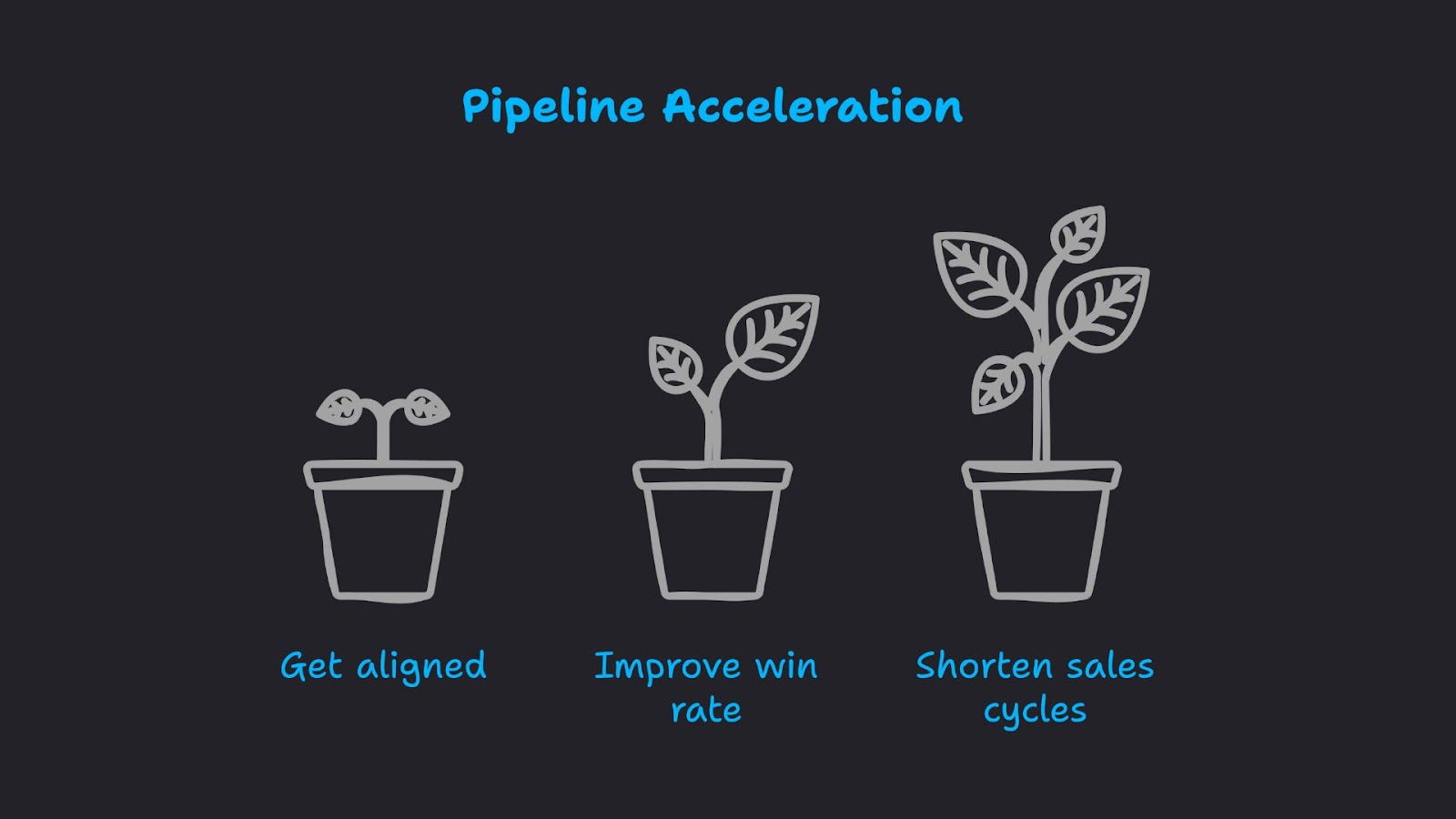
Tip #2: Start targeting your open opportunities with LinkedIn Ads
Once you have buy-in from internal stakeholders, I recommend getting started with LinkedIn Ads.
For your targeting, you can create a dynamic list of open opportunities in HubSpot and connect it to LinkedIn Campaign Manager. And if you’re using another CRM, such as Salesforce, you can send your open opportunities to LinkedIn Campaign Manager via Zapier.
On top of this company list of open opportunities, you’ll want to layer on job titles within your DMU (decision-making unit) – these are all the people that may be involved in sales conversations.
For example, if you’re selling an attribution tool, you might want to reach RevOps, Marketing, Sales, and Business Development job titles at your target accounts.
Marketing job titles (VP of Marketing, Head of Demand Gen, Chief Marketing Officer) will likely push the deal forward, but other departments will need to sign off in order for a purchase to be made. By building trust within all these key departments, you’ll increase the likelihood of a deal moving over the finish line.

Pro tip: If you don’t have a massive list of open opportunities, you may not be able to layer on job titles, as your audience size will be too small. If you run into this issue, try using job function targeting instead.
Tip #3: Tailor your messaging to different personas
If you have a large enough audience size to do so, consider creating different campaigns for each persona within your DMU (decision-making unit). For example:
Campaign 1: Open opportunity companies + Marketing job titles

Campaign 2: Open opportunity companies + Finance job titles

Campaign 3: Open opportunity companies + Sales job titles
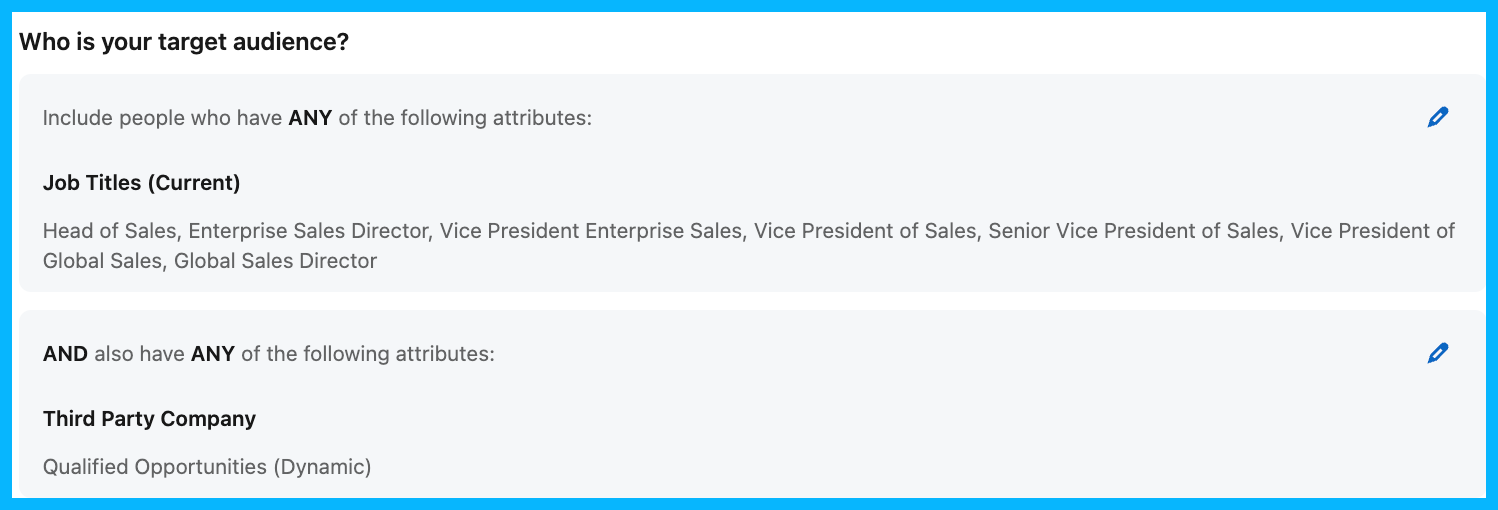
By separating these different personas into different campaigns, you can create messaging that’s more relevant to each department – marketing ads could focus on measurement, finance ads could focus on revenue, sales ads could focus on closing more deals, etc.
With more tailored messaging, your ads are more likely to resonate and leave an impression on different departments.
Tip #4: Measure the impact of your campaigns
Once your campaigns are live, you need a way to measure (and prove) that they’re working.
Here’s how I recommend doing it:
1. When a deal closes, go to the Companies tab in LinkedIn Campaign Manager and see how many impressions (and engagements) the Closed Won company received. If you see a lot of impressions and engagements, it’s safe to assume that your ads played a role in the eventual conversion.

2. To take things up a level, consider using a tool like Fibbler, which sends ad impressions on a company level back into HubSpot – this will allow both your marketing and sales team to see how many ads companies saw before making a purchase.
3. If you have a larger budget, consider investing in a tool like Dreamdata or HockeyStack, which will provide more details on the incremental lift driven by your pipeline acceleration campaigns.
4. For a true A/B test, manually split your open opportunities into two different groups, and expose only one of them to the pipeline acceleration ads. Are the exposed companies closing faster and at a higher rate?
5. To further understand the impact of your campaigns, ask the POC of your new customers if they happened to see your ads, and if those ads influenced their decision in any capacity.
Tip #5: Don’t forget to exclude your customers
This is simple, but extremely important: Don’t forget to exclude new customers from your pipeline acceleration campaigns.

If your customers continue seeing ads from your company during their onboarding phase, you may end up annoying them, in addition to throwing money down the drain.
Making these exclusions is straightforward: when a company transitions from opportunity to closed won in HubSpot, they should be added to a new dynamic list of customers, which can be connected to LinkedIn Campaign Manager and added as an exclusion list in your pipeline acceleration campaigns.
If you’re using a different CRM, the process is similar, you’ll just have to make the connection through Zapier instead.
Tip #6: Apply the same playbook to upsells and cross-sells
Once this playbook is working well for pipeline acceleration, you can apply it (with a few modifications) to upsells and cross-sells.
For example, if you launch a new product, you could target a list of all your existing customers highlighting its capabilities, and outlining how it will enhance their existing workflows. Check out an example from ZoomInfo below:
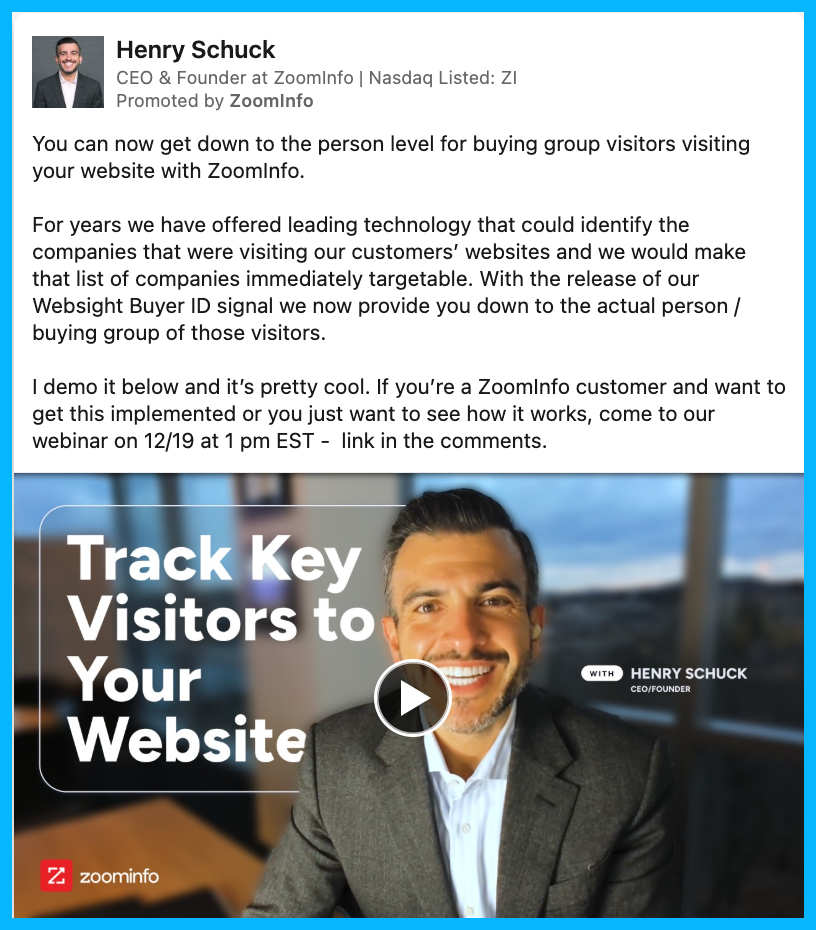
The possibilities are endless once you understand the fundamentals of LinkedIn’s targeting – any lifecycle stage can be targeted with relevant content and offers.
Tip #7: Incorporate different channels into the mix
Once LinkedIn Ads are working well for you, consider adding other channels and strategies into the mix to create a sense of omnipresence.
For example, maybe you could test Meta or Reddit retargeting ads (depending on where your audience spends the most time).
It’s also a great idea to leverage LinkedIn organic, to expand your reach beyond paid ads.
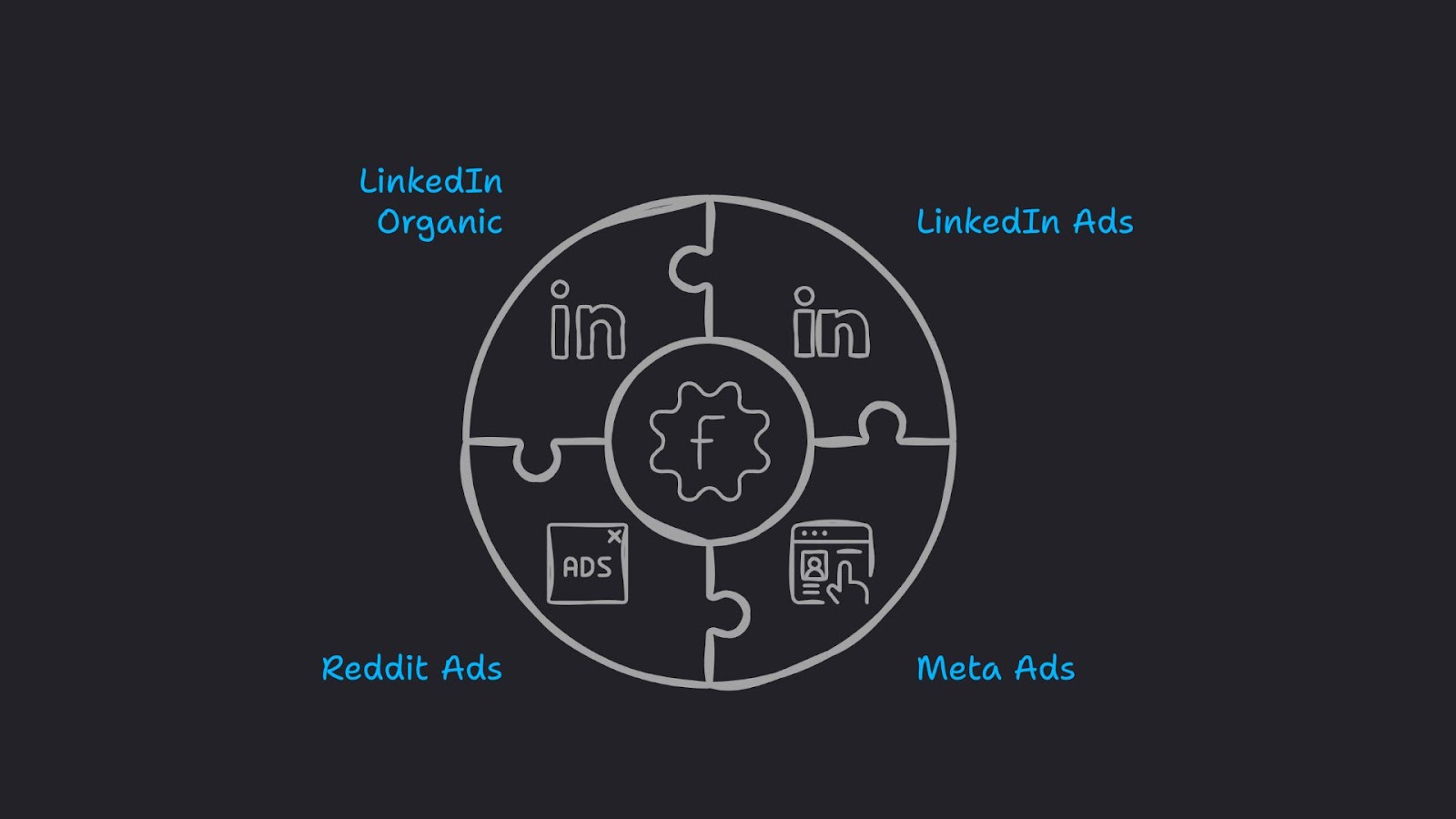
Your Head of Sales, Chief Commercial Officer, members of your marketing team, and other employees who are consistently posting on LinkedIn can connect with people within the DMU (Decision-making unit) at your open opportunity companies – this way, they’ll be seeing content from your organization constantly, and you’ll be top of mind throughout the entire sales process.
Tip #8: Use thought leader ads
To maximize the impact of your ads, you ideally want your team to be posting relevant content on LinkedIn, and you can take things to the next level by running thought leader ads, boosting the top performing posts from your team members to your list of open opportunities.
For example, if your Head of Sales makes a post related to the capabilities of your product and it goes viral, you can put some ad spend behind this post, targeting all your open opps – this will serve as great social proof, reassuring members of the DMU that working with your company is the right decision.
The added benefit of thought leader ads is that they don’t look like ads at all, and typically drive more interest and engagement than standard company ads.
Here’s a good example from Sendoso:
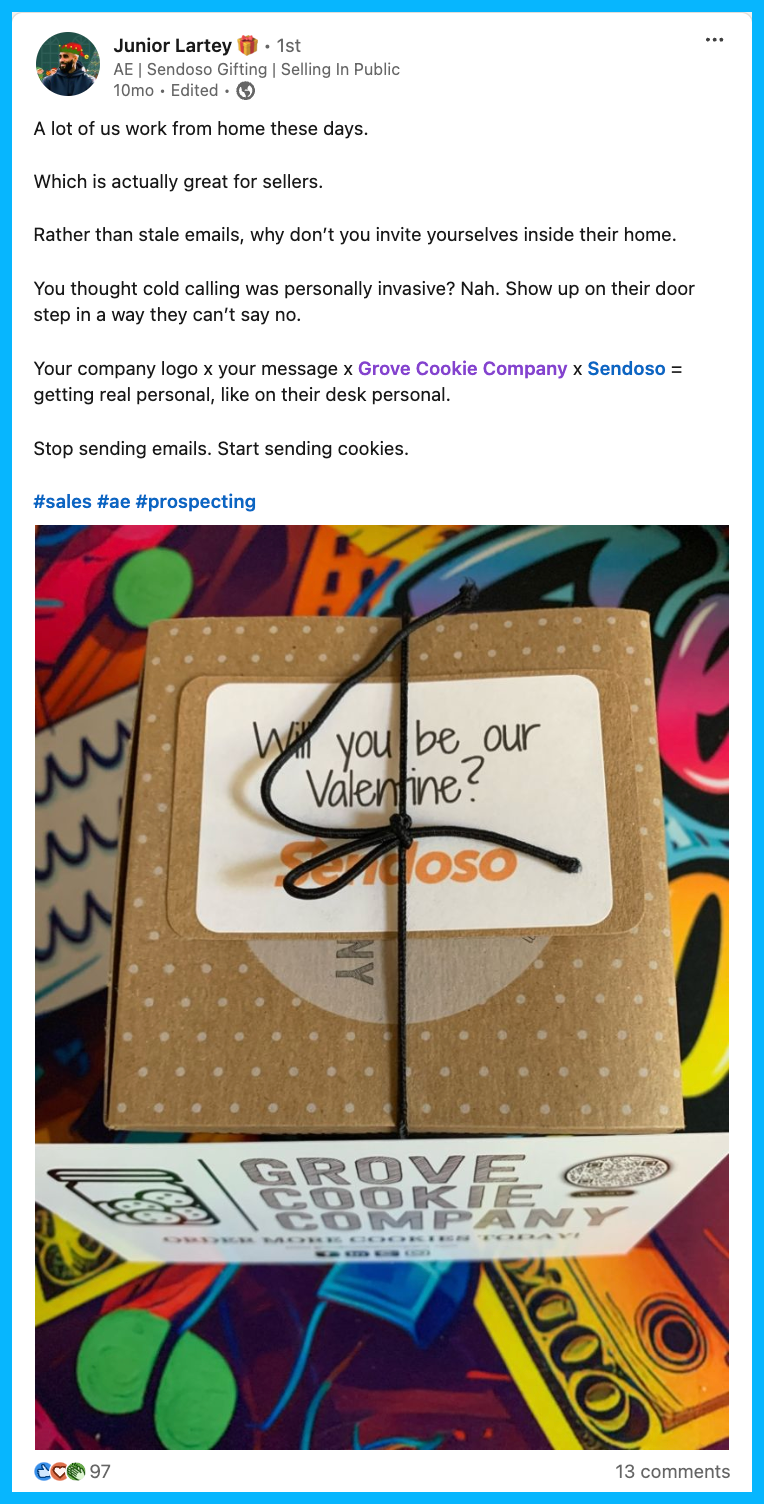
Tip #9: Leverage signals to understand how deals are progressing
To understand how deals are progressing, take a look at the signals that are available to you.
Is a specific company seeing your ads a lot? Are they engaging frequently? Are they going a step further and visiting your website? (you can easily see this using a tool like Warmly, LeadInfo, or Leadfeeder)
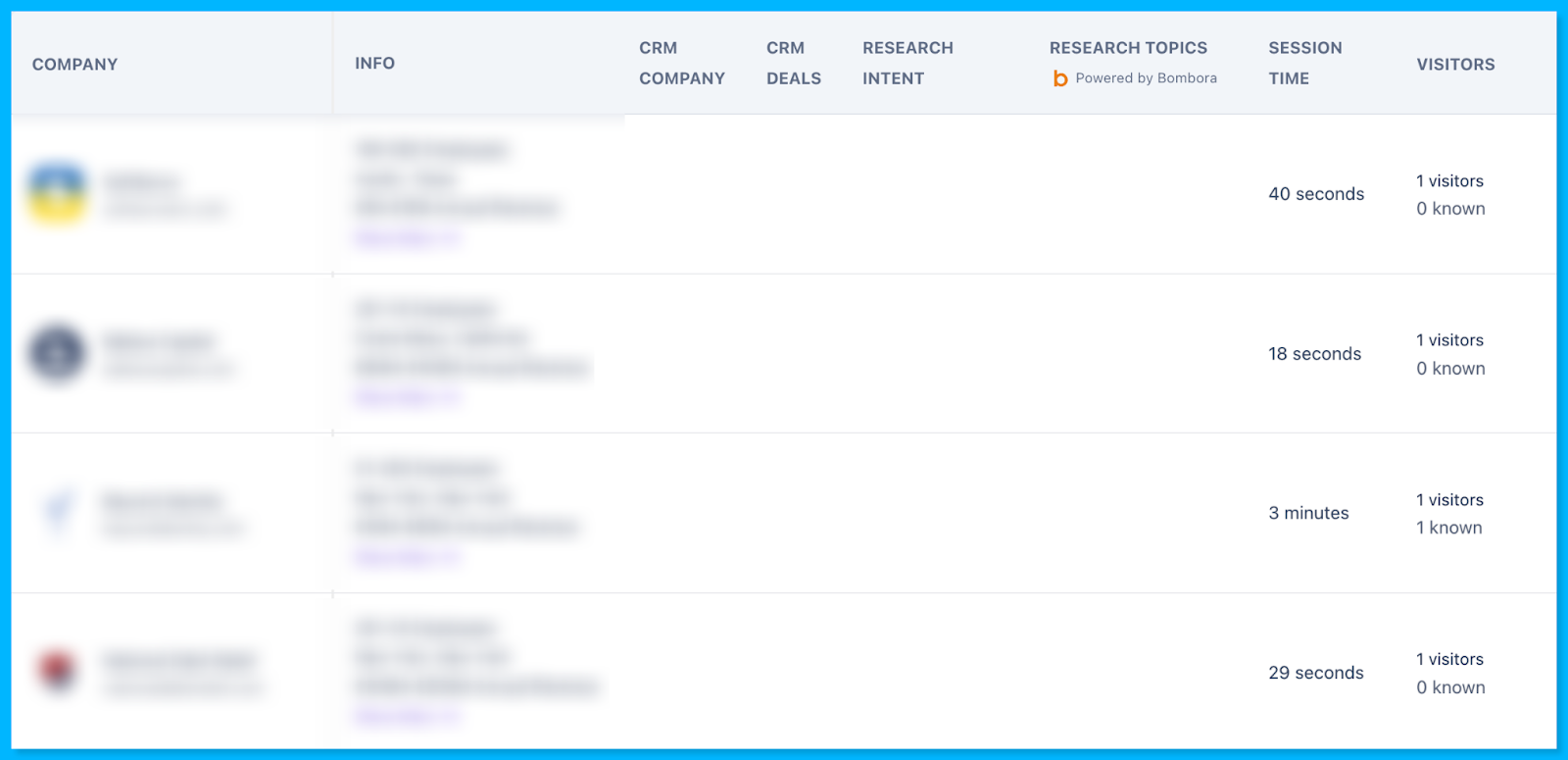
If you’re in the US and have access to person-level identification tools, you can even see some of the people that are visiting your site. For example, if the CFO, CMO, and CTO are all visiting your website, you can infer that the deal is progressing rapidly and chances of a purchase are high.
Tip #10: Use insights from closed lost campaigns to tweak your strategy
Keep a close eye on closed lost deals and look for recurring patterns.
Are you consistently losing on pricing, timing, or to a specific competitor?
This is great intel for messaging in future pipeline acceleration campaigns – if you can get ahead of potential objections, the likelihood of an opportunity closing is significantly greater.
For example, let’s say you’re reviewing a year of data and notice that you lost most of your deals to a specific competitor.
In your future pipeline acceleration campaigns, you might want to run competitive ads, highlighting the benefits of choosing your product. This might help prospects who are thinking of working with your competitor choose to work with your company instead.
Here’s a great example from Cognism:
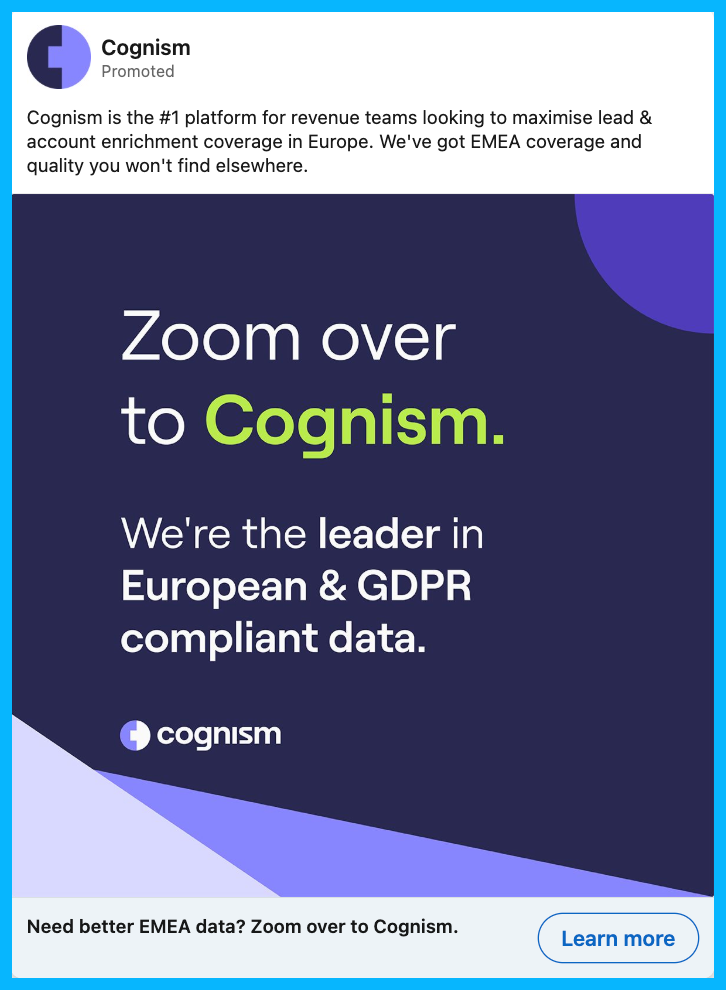
Hope you found this article helpful!
Feel free to reach out on LinkedIn with any questions about pipeline acceleration, paid media strategy, or B2B marketing.

SEO for B2B SaaS: 10 Tips to Drive Pipeline and Revenue
Over the past five years, I’ve helped B2B SaaS companies like Clickhouse, WildSparq and EventsAir drive millions in pipeline and revenue through SEO.
My lesser-known strategies have been featured by CXL, Ahrefs, The Marketing Millennials and more.
Along the way, I’ve developed an SEO playbook that B2B SaaS companies can follow (step by step) to start seeing high quality inbound leads in a matter of months.
I’ll be breaking down my entire process below 👇
TABLE OF CONTENTS
- Tip #1: Define Your Money Keywords
- Tip #2: Understand What's Already Ranking
- Tip #3: Build a Best-in-Class Page
- Tip #4: Nail the basics
- Tip #5: Build Quality Backlinks for $0
- Tip #6: Publish At Scale
- Tip #7: Design Pages That Convert
- Tip #8: Leverage sales calls, customer success calls, and customer research
- Tip #9: Keep Improving
- Tip #10: Scale as you grow
Tip #1: Define Your Money Keywords
Most B2B SaaS companies see SEO as a checkbox on their to-do list.
The CMO or CRO says, “Competitors are outranking us, we need to do some SEO.”
And marketers, who are already juggling a million different tasks, simply go to Semrush or Ahrefs, find some keywords with low difficulty and high search volume, throw them into ChatGPT, and publish a few articles.
Unsurprisingly, this doesn’t yield inbound leads and has minimal impact on revenue.
For SEO to actually drive results, you need to focus on the keywords that your dream clients are searching, or what I like to call “money keywords.”
Here’s a matrix that you can use to identify them:

Column 1: Make a list of your main offers (ie calendar scheduling)
Column 2: Make a list of the industries you serve best (ie sales, HR, marketing, etc.)
Column 3: Make a list of your main competitors (ie Chili Piper, Calendly, HubSpot)
Column 4: Make a list of the problems you solve, or jobs to be done (ie struggling to route leads efficiently)
Now, you can use these columns to create high-intent long-tail keywords. For example:
1. Best calendar scheduling software
2. Calendar scheduling for sales teams
3. Chili Piper alternatives
4. How to route leads more efficiently
Keep in mind, these “money keywords” will probably have a low search volume, and that’s okay. At the end of the day, you want traffic that will convert into pipeline, not a large number of visitors outside of your ICP.
When you’re doing this exercise, make sure to involve your founder (if you’re a smaller founder-led company) or your sales team (if you’re a larger sales-led organization) – they’ll likely have great insights related to the problems you solve.
Tip #2: Understand What’s Already Ranking
Now that you’ve identified those money keywords, type them into Google to see what type of content is already ranking organically.
For example, if you type in “Chili Piper alternatives” you’ll find that the top organic search results are something along the lines of “Top 10 Chili Piper alternatives to consider”, or what is commonly referred to as a product listicle.

Look through these existing articles and think about what your company can do even better. Can you include a comparative table or social proof, and clearly demonstrate why you’re the best without sounding overly biased?
Or, if you’re creating an article on how to speed up the lead routing process, look at the guides at the top of the SERP and think:
How can I create similar articles that are even more helpful? How can I demonstrate greater experience, expertise, authority, and trustworthiness?

Maybe it’s by going much more in-depth, or weaving in relevant videos, or highlighting screenshots of your product.
Pro tip: Don’t be afraid of highlighting your product throughout your articles. As marketers, we often worry about sounding too promotional, but the truth is, you need to show that your product is the obvious solution to a problem in order to drive revenue.
Tip #3: Build a Best-in-Class Page
Once you’ve researched what top-ranking pages are doing, it’s time to figure out how to blow them out of the water.
If you’re creating a listicle, can you add better visuals, weave in your product more, or add relevant CTAs?
If it’s a how-to article, can you link to a lead magnet or a YouTube video with more helpful context?
If it’s a landing page, can you add a more comprehensive FAQ section that answers all of your prospect’s questions?
Pro tip: Always consider where your prospect might be in their journey based on their search query. For a more top of funnel how-to article, you can include more subtle CTAs and connections to your product, while for a competitor comparison article, it makes more sense to include a clear demo request CTA.
Tip #4: Nail the basics
Technical SEO is important for e-commerce sites with thousands of pages, but most B2B SaaS websites (which are often 50 pages or less) don’t need a ton of technical SEO to win.
Sure, you still need the basics.
For example, let’s say you write an article related to the keyword “Best calendar scheduling software.”
You’d want your slug to be “best-calendar-scheduling-software”; you’d want to include your keyword in your H1, meta title, and meta description; and you’d want to incorporate the keyword naturally throughout your article.
You’d also want good UX, a clear menu nav, solid design and UI on both mobile and PC, some internal links to relevant topics throughout your website, and some other pages linking back to your article.
That’s really all you need.
After you have these basics in place, focus on producing a high volume of content that’s relevant to your prospects, and don’t lose sleep over technical optimizations.
Tip #5: Build Quality Backlinks for $0
Even if you have the best content, ranking for your dream keywords isn’t easy, especially if your competitors have been around for decades and have extremely high domain authorities.
To compete against the giants and set yourself up for success, you need high quality backlinks to your website.
Here’s one of my favorite ways to get them:
1. Go to Semrush or Ahrefs, whichever keyword research tool you prefer, and paste the LinkedIn profile URLs of your thought leaders (Founder or other execs) into the backlinks tab.

2. In the results, you’ll find a list of all the articles featuring your thought leaders and linking out to their LinkedIn profiles.

3. Message these companies and see if they can update the articles to link to your website, not just to the LinkedIn profile URL. Even better if you can get a backlink to one of your high-intent pages.
After doing this, you can go a step further and visit the podcast search engine Listen Notes, type in your niche (ie B2B ads, recruitment, sales enablement), filter by top podcasts in your space, and make a list on a Google sheet.

Next, have your thought leaders reach out to the podcast hosts via LinkedIn.
The message can be short and simple, such as: Hey Sam, enjoyed your recent episode on X, had an unusual idea for your show. Are you against a conversation?
From my experience, around 20% of hosts will respond, and your thought leaders will start getting featured on amazing podcasts, which will eventually lead to more backlinks to the company website.
Pro Tip: To start seeing results quickly, aim to send 5-10 messages per week to podcast hosts in your space.
Tip #6: Publish At Scale
With SEO, quality matters, but quantity is a massive competitive advantage.
Larger companies are spending a lot of money on ads, content marketing, and events, but they typically have a ton of red tape.
They may take two weeks to approve a topic, a month to plan out the content, a month for design, a month for web development, a month to publish… Which is to say, by the time they’ve published 2 or 3 pages, you could have published 30, 40, or 50 quality articles, and started stealing some of the market share.
To start seeing results, publish as much content as possible focused on your money keywords (occasionally weaving in more top of funnel content).
Also, remember, unless you’re a super authoritative company, it’ll usually take 2-3 months for Google to crawl your pages, so the content you publish today is setting you up for success 90 days from now.
Tip #7: Design Pages That Convert
If you’re investing a lot of money in content, make sure you also invest in great design. The better the user experience, the more likely you are to drive conversions.
Here are some questions to ask yourself:
- Are your pages aesthetically pleasing?
- Is your content skimmable on both mobile and PC?
- Are you including screenshots, videos, or aha moments that relate to your product?
- Can you add more social proof (customer quotes, guides, walkthroughs) to increase trust?
- Are you sprinkling relevant CTAs throughout your content?
- Can you add sticky CTAs that are aligned with the funnel stage of each article (ie subscribe to newsletter for more top of funnel articles, request a demo for more bottom of funnel content)?

These changes, which might seem small, can lead to massive improvements in performance.
Tip #8: Leverage sales calls, customer success calls, and customer research
You can rank pages using generic AI-generated content that says things like “turbocharge your revenue” or “10X your productivity,” but prospects will immediately bounce.
If you want them to stay on your page – and possibly even schedule a demo – you need to write in-depth content that resonates with their exact pain points.
Looking at customer research and listening to calls is a great starting point. Even better if you can take your sales and CS teams out to lunch, walk them through the topics you’re tackling in your content, ask for additional insights, and weave these insights into your articles.
This way, all the content you create will be amazing for sales enablement in addition to SEO.
Tip #9: Keep Improving
As I mentioned previously, to win with SEO, you need to publish content quickly – when it’s ready, not when it’s perfect.
That being said, you should always be looking for ways to improve the content you’ve already published.
About 2 or 3 months after publication, check how your article is ranking.
For example, let’s say you write an article, and after a few months it settles at position number 7. You could look at this article more closely, and think of ways to get it closer to number 1.
Could you add a more comprehensive FAQ section, embed a relevant YouTube video, add nicer images of your product, include more customer quotes, or earn a few high quality backlinks?
These consistent optimizations can go a long way if you want to move up in the rankings.
Tip #10: Scale as you grow
SEO isn’t something you can set and forget – even if you’re an established company, there’s always room for improvement.
Once you’ve implemented tips 1-9, think of ways you can scale your efforts even further.
Can you increase your article production by hiring more team members or working with freelancers? Or create incredible resources (such as custom tools) that will be highly valuable to your ICP?
Also, don’t just think about SEO – after all, SEO is only a piece of the marketing ecosystem – think of ways to improve your ads, your YouTube channel, your podcast, your LinkedIn page, etc.
Improvements in all these areas will lead to greater brand awareness and trust, which will lead to more successful SEO.
Hope you found this article helpful!
Feel free to reach out on LinkedIn with any questions, or check out the Breaking B2B website or Breaking B2B podcast for more unusual B2B/SaaS SEO insights.
Resources for mastering B2B advertising
If you’re serious about mastering B2B advertising then you definitely need to join 1,000+ B2B marketers leveling up their paid advertising skill sets in AdConversion.
Here’s 4 reasons why you should consider joining. Every one of our on-demand courses are:
✅ 100% free access.
✅ Taught by vetted industry experts.
✅ Have workbooks, resources, and templates.
✅ Less than 10 minutes per lesson.
We believe every marketer should know how to scale paid ads so they can:
- Scale their ideas
- Level up their careers
- Make a positive impact
Click Here to Join 1,000+ B2B Marketers Today and start leveling up your advertising skill set.
Takes < 90 seconds to sign up (seriously we timed it 😂)
People Also Ask
How can I effectively measure the ROI of my SEO efforts in a B2B SaaS context?
Utilize key performance indicators (KPIs) such as organic traffic growth, conversion rates, and customer acquisition costs. Implement tools like Google Analytics and CRM systems to track the journey from organic search to lead conversion and revenue generation.
What are the best practices for conducting keyword research tailored to B2B SaaS audiences?
Focus on identifying high-intent keywords that align with your product’s solutions to specific business challenges. Consider the different stages of the buyer’s journey and develop content that addresses each phase, from awareness to decision-making.
How can I optimize my website’s technical SEO to support scalable growth for a B2B SaaS company?
Ensure your website has a clean architecture with logical URL structures, fast load times, and is mobile-friendly. Regularly audit for issues like broken links or duplicate content, and implement structured data to enhance search engine understanding.
What role does content marketing play in enhancing SEO for B2B SaaS, and how can I develop an effective content strategy?
Content marketing is pivotal in attracting and engaging your target audience. Develop a strategy that includes creating valuable, informative content such as blog posts, whitepapers, and case studies that address your audience’s pain points and demonstrate your expertise.
How can I build high-quality backlinks to improve my B2B SaaS website’s domain authority and search rankings?
Engage in thought leadership by contributing guest posts to reputable industry publications. Develop shareable content assets like original research or infographics, and foster relationships with industry influencers to encourage natural backlinking.

10 Tips to Create Winning LinkedIn Thought Leader Ads
Since their introduction in 2023, I’ve run hundreds of LinkedIn thought leader ads, for my demand gen agency, Omni Lab, and for my clients in B2B SaaS.
Through my experimentation with this format, I’ve developed a list of best practices to maximize the chances of success.
I’ll be sharing all my insights below 👇
TABLE OF CONTENTS
- Tip #1: Remember that thought leader ads are just sponsored posts
- Tip #2: Make sure your ads connect to your product
- Tip #3: Create content people would pay for
- Tip #4: Add Premium CTAs to your LinkedIn profile
- Tip #5: Test Non-Employee Influencer Campaigns
- Tip #6: Optimize your LinkedIn profile as if it were a landing page
- Tip #7: Look at the right metrics
- Tip #8: Give yourself a reality check
- Tip #9: Put yourself in your buyer’s shoes
- Tip #10: Focus on Awareness, Not Conversions
Tip #1: Remember that thought leader ads are just sponsored posts
First of all, remember that thought leader ads are not a silver bullet that will save your marketing program – they’re simply sponsored organic posts that can fit into your larger content strategy.
This isn’t to downplay the power of this format; targeting your ICP with content from your thought leaders is one of the most effective approaches to build brand awareness and mental availability.
That being said, your thought leader ads won’t be successful if you don’t have great positioning, messaging, content, or targeting.
The standard rules of marketing still apply.
Tip #2: Make sure your ads connect to your product
If you’re putting ad dollars behind organic posts, make sure they connect back to your product in some capacity.
I don’t mean adding a demo request CTA to every post, but the content you promote should have a core dotted line back to your product.
For example, at Omni Lab, I could promote a post highlighting our unique POV and approach to Google Ads, which is one of the services we offer. If this POV resonates with my audience, they’ll most likely think of me when they’re looking for support with their Google Ad campaigns.
Personal posts, such as occasional pictures of food or selfies on the beach, are okay, but they don’t deserve to be promoted.
At best, they won’t generate significant awareness for your product, and at worst, they’ll end up confusing your audience.
If your ICP loves you but they have no idea what you do, you probably won’t be in business for long 😬
Tip #3: Create content people would pay for
No matter how great your targeting or technical setup, you won’t get very far if you don’t have amazing content that people would be willing to pay for – this is true for ads in general, and especially true for thought leader ads.
Take some time to reflect on your offer. Are you just providing generic tips that people have heard many times? Or are you offering something unique and valuable that will pique the interest of your audience?
To give an example, for Omni Lab, I could run thought leader ads highlighting Google Ads bidding strategies. But it would be more effective to share in-depth campaign recommendations for my target accounts.
Or, if you’re a company like Navattic, you could run ads talking about interactive demos, but it would be more powerful to build out personalized interactive demos for your dream companies.
Next time you run a thought leader ad campaign, focus on increasing the perceived value of your offer, and you’ll see a massive improvement in performance.
Tip #4: Add Premium CTAs to your LinkedIn profile
If you’re looking to funnel people into an owned audience, such as your newsletter, consider adding a Premium CTA to your thought leader ads. This is something I do at Omni Lab, and it’s helped me generate hundreds of high quality email subscribers.

This CTA option is only available to LinkedIn Premium users: you can add CTAs such as View my newsletter, Visit my website, View my blog, etc., depending on the action you’d like your audience to take.
If you don’t have LinkedIn Premium, consider editing your post once the organic reach has died down (usually within 72 hours), adding a CTA with a link to your website.
Even though the primary goal of thought leader ads should not be to drive direct clicks and conversions, adding a CTA allows people to learn more about your company without having to go on a scavenger hunt.
Tip #5: Test Non-Employee Influencer Campaigns
After running hundreds of thought leader ads, both for Omni Lab and for my clients, I’ve found that thought leader ads from non-employees consistently outperform promoted posts from employees.
For example, at Omni Lab, we built out a media plan and campaign strategy for Navattic, and their Head of Growth and Operations (Natalie Marcotullio) made a post related to this.
We boosted this post to our target audience, and it was one of our top performing ads of all time, significantly outperforming all the thought leaders ads from me and my cofounder.

Clay is another great example of non-employee thought leadership. Members of their creator program post about how they use the software, and Clay promotes these posts to increase awareness for their company, while simultaneously expanding the reach of their creators – they’ve created a symbiotic relationship where everybody wins.

If you’re working with well-known people in your industry, consider how you might be able to partner with them: this could look like an audit, a strategy, a discount, access to exclusive features, etc. in exchange for promotion on LinkedIn.
Tip #6: Optimize your LinkedIn profile as if it were a landing page
When you’re running thought leader ads, your LinkedIn profile turns into your landing page – it’s the place where people go for more information about you and your company.
Here are a few tips to optimize your profile that I always share with my clients:
1. Make sure you have a banner image explaining what you do at a high level.

2. Make sure your profile photo is up to date, and use your primary brand color as the background.
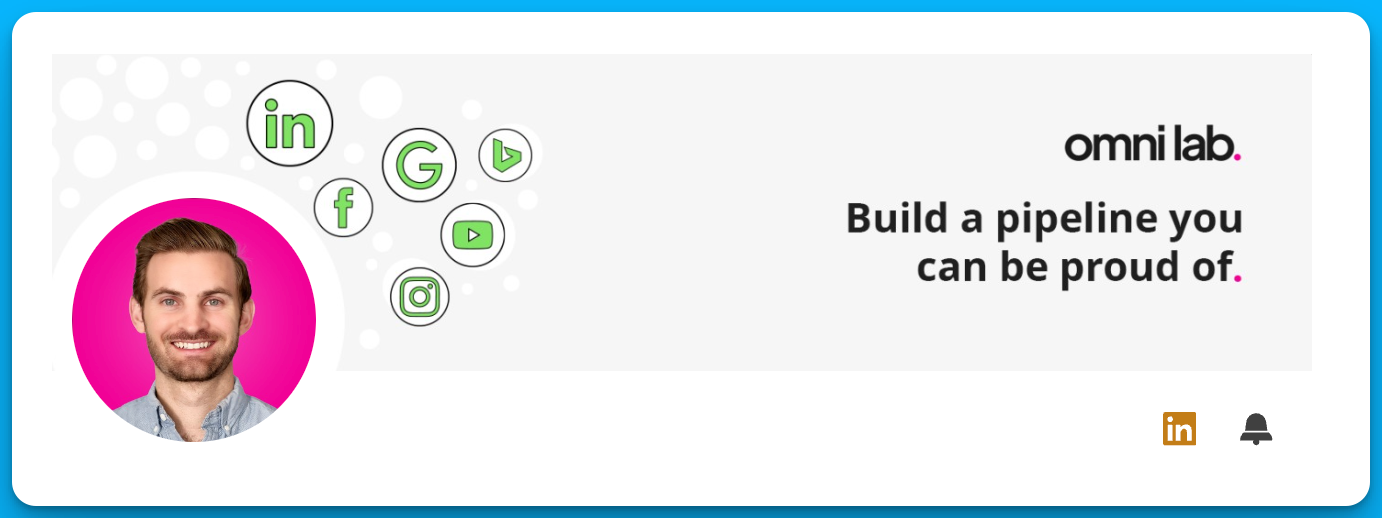
3. Add what you do + the category you play in to your headline

4. Use the About section to explain why your company exists and how you approach things differently (bonus if you can also add a few testimonials)

5. Use the featured section to highlight your core CTA + top performing posts demonstrating your expertise

Tip #7: Look at the right metrics
Let’s say you have all the fundamentals in place: an optimized profile, great content, solid targeting, etc.
Now, the next step is to ask yourself: What metrics should we look at to understand if our content is working?
Here’s what I recommend to my clients:
1. First of all, check your LinkedIn demographics report to make sure that you’re actually reaching your ICP.
2. Check in-platform metrics such as impressions, engagement, and CTR. If these metrics look healthy, you’ll know that your audience is finding value in your content.
3. Look at smaller microconversions, such as engaged visits on your website. Are the people reading your thought leader ads eventually navigating to your site to learn more?
4. Look at the self-reported attribution field on your demo request form. Are more people mentioning your thought leaders? If the answer is yes, you’ll know that your content is building trust with the right people.
5. Finally, you can look at more bottom of funnel metrics, such as sign ups or meetings booked, but ultimately, DO NOT obsess over these metrics. Prioritize numbers 1-4 to understand if your content is resonating – it might take a while to see a significant impact on pipeline and revenue.
Pro Tip: If you’re not sure what content to promote as thought leader ads, look for posts that had a 2-3% CTR organically. In my experience, these posts with a higher organic CTR are also the top performing ads.
Tip #8: Give yourself a reality check
Most people – and B2B buyers especially – aren’t making impulse decisions and can’t be pushed through a funnel.
As the Ehrenberg-Bass Institute has highlighted, if you look at how often prospects make a purchase in your category, you’ll quickly realize how few of the people you’re targeting are actually in-market.
Even if you run the greatest ads in the world, you can’t expect people to schedule a demo if they aren’t actively looking for a solution.
And even if they do book a demo, if you have a higher ACV, you’ll probably have an extremely long sales cycle.
My point is, you can’t expect hundreds of demos or millions in revenue right away.
Tip #9: Put yourself in your buyer’s shoes
This is a fun exercise I like to do with my clients.
I ask: “When you see posts on LinkedIn, what actions do you usually take?”
Usually, the response is something along the lines of:
“I read and keep scrolling…” or “If I like something, I might react or leave a comment…”
Then I ask the follow-up question: “If you see a post you like from a company you’ve never heard of before, would you immediately book a demo?”
And typically the answer is “No, of course I wouldn’t.”
Our prospects aren’t that different than we are; if we wouldn’t buy immediately, they probably won’t either.
If you’re getting good engagement and starting to see other signs of life (such as engaged website visits), you’re headed in the right direction, even if you’re not seeing more demos and sign ups right away.
Tip #10: Focus on Awareness, Not Conversions
Think of thought leader ads as a brand awareness play, not a direct response tactic.
Like any good brand marketing, your thought leader ads should relate to key buying situations, or category entry points.
For example, if I promote posts about how we help our clients improve their lead quality, prospects may think of Omni Lab if they ever run into lead quality issues.
Or maybe I talk about how we use paid media to increase brand awareness, and prospects may think of us if they’re having a brand awareness problem.
The key to succeeding with thought leader ads is putting the right messages in front of the right people. If you do this over a long enough period of time, the pipeline and revenue will follow.
Hope you found this article helpful!
Feel free to reach out on LinkedIn or Omni Lab with any questions about demand gen or paid media.
Master B2B LinkedIn Ads with these 3 Free Courses:
If you want to become a LinkedIn Ads pro, check out our free B2B LinkedIn Ads courses, where you'll learn how to launch, optimize, and scale your campaigns to drive pipeline and revenue.
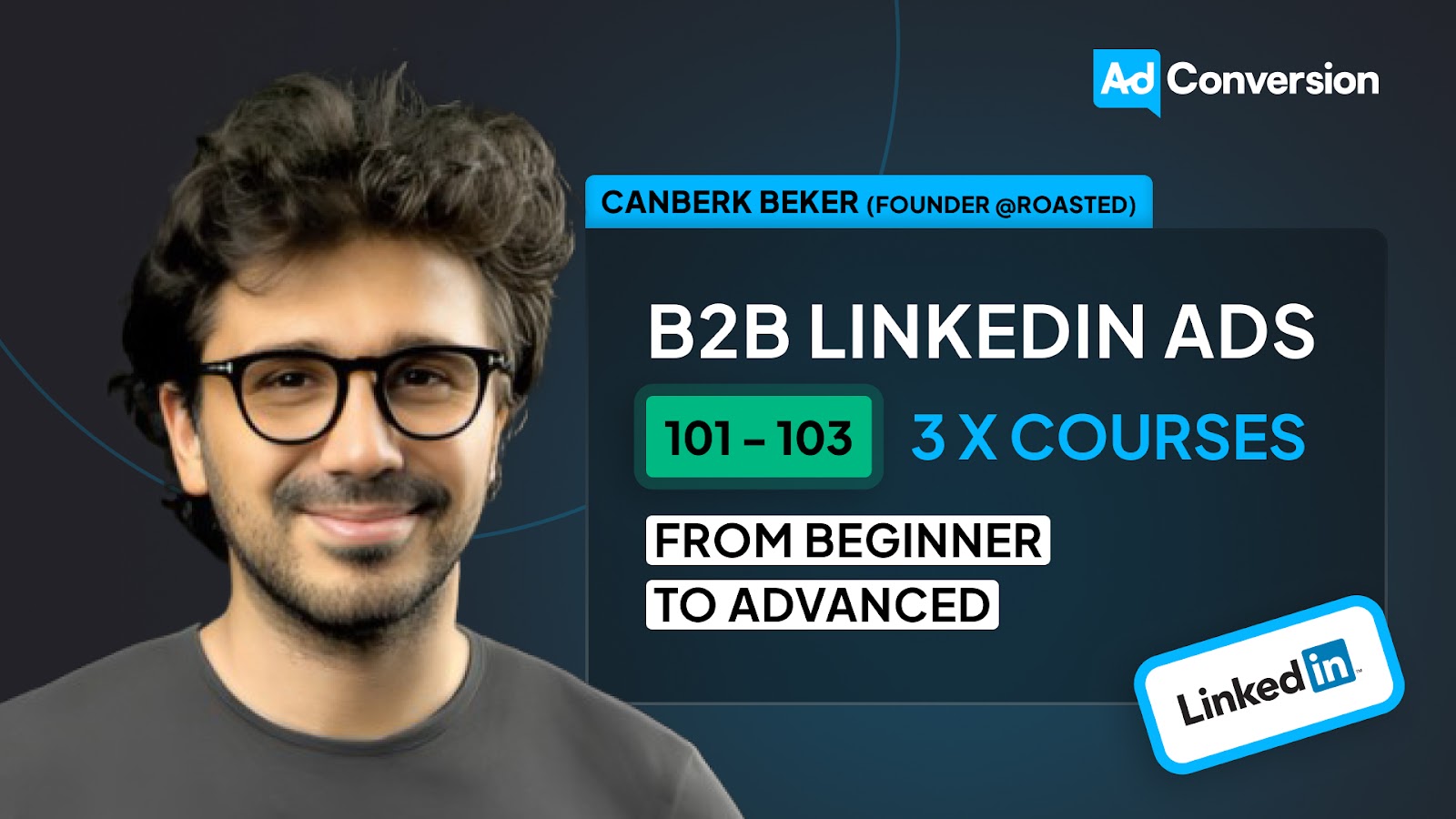
Here's what you'll learn in each course:
⚙️ B2B LinkedIn Ads 101 - The Ultimate Crash Course for New LinkedIn Advertisers
- Foundations For LinkedIn Ads Success
- Measurement: Tracking & Key Principles
- Targeting: Reaching Your Dream Buyers
- Ads: Mastering The 9 Ad Formats
🎯 B2B LinkedIn Ads 102 - The Blueprint for LinkedIn Ads Optimization
- Monitoring: How To Spot Performance Trends
- Auditing: How To Find The Darlings You Need To Kill
- Reporting: How To Transform Data Into Insights
- Optimization: How To Make Your LinkedIn Ads Profitable
🚀 B2B LinkedIn Ads 103 - Advanced Scaling Strategies From $25M In Ad Spend
- Concepts of Scaling
- Divide and Conquer
- Learnings From $25M+ In LinkedIn Ad Spend
Click Here to Join 1,000+ B2B Marketers Today and start leveling up your advertising skill set.
Takes < 90 seconds to sign up (seriously we timed it 😂)
People Also Ask
What are LinkedIn Thought Leader Ads?
LinkedIn Thought Leader Ads are sponsored posts that promote content from personal profiles, allowing companies to leverage the personal brand and credibility of their thought leaders to engage target audiences authentically. 
How can I ensure my Thought Leader Ads align with my product?
Ensure that the content in your Thought Leader Ads connects back to your product or service, even subtly. While not every post needs a direct call-to-action, there should be a clear link between the content and what your company offers to maintain relevance and drive interest. 
What type of content works best for Thought Leader Ads?
Content that offers unique, valuable insights or information that your target audience would find beneficial tends to perform well. Aim to create posts that people would be willing to pay for, as this indicates high value and relevance. 
How should I optimize my LinkedIn profile for Thought Leader Ads?
Treat your LinkedIn profile like a landing page: use a banner image that explains your role, ensure your profile photo is professional, craft a headline that clearly states what you do, and utilize the ‘About’ section to detail your company’s mission and unique approach. 
What metrics are important to track for Thought Leader Ads?
Monitor metrics such as impressions, engagement rates, click-through rates (CTR), and audience demographics to assess whether your content resonates with your target audience. Additionally, track website visits and self-reported attribution to understand the broader impact on your marketing funnel.

Become a part of the best B2B Ads community ❤️











